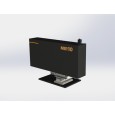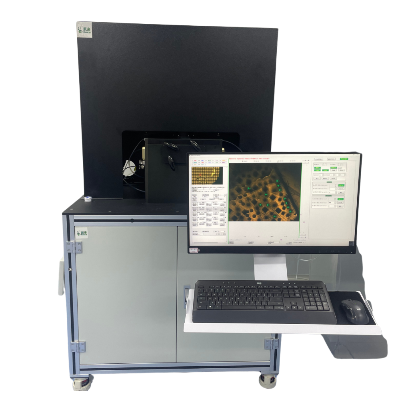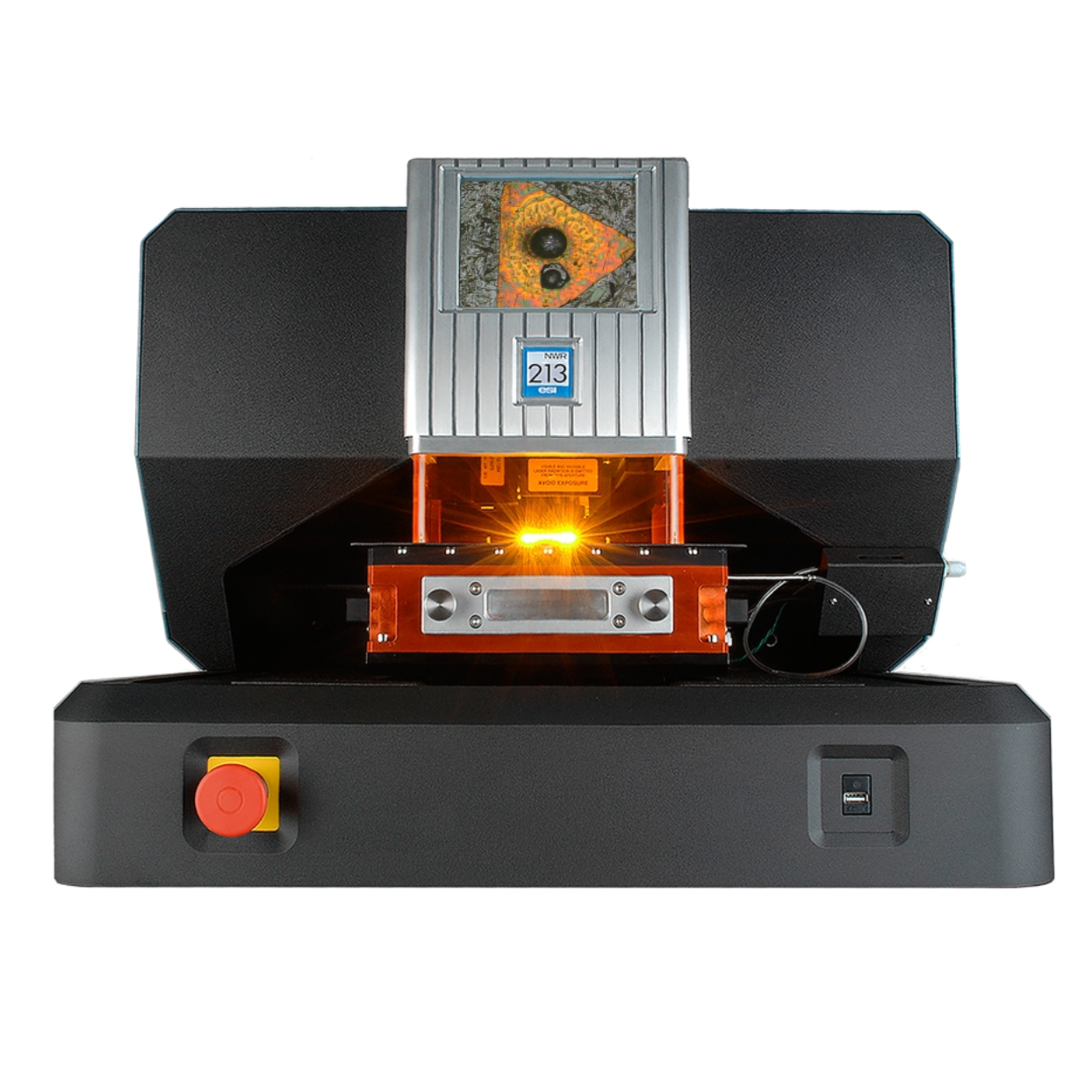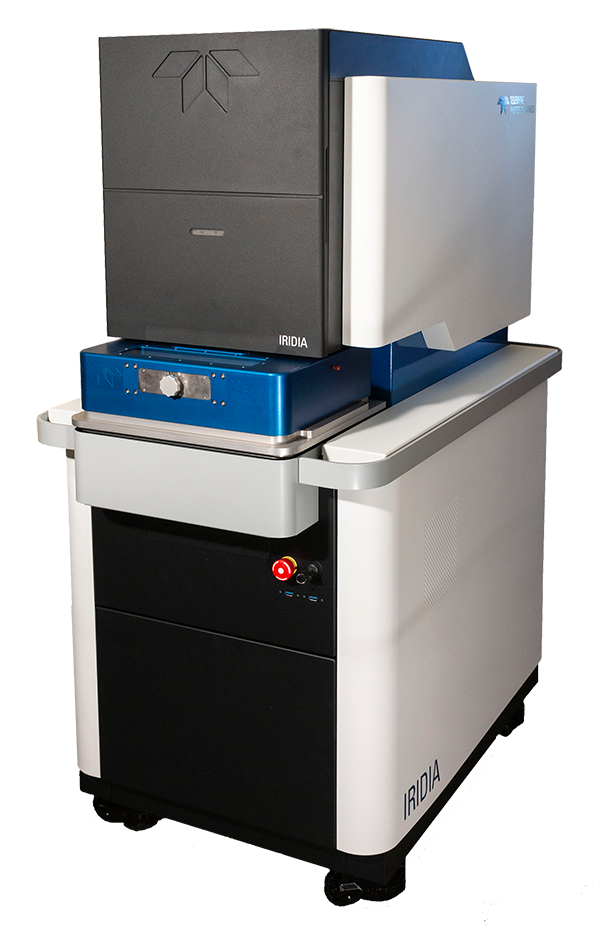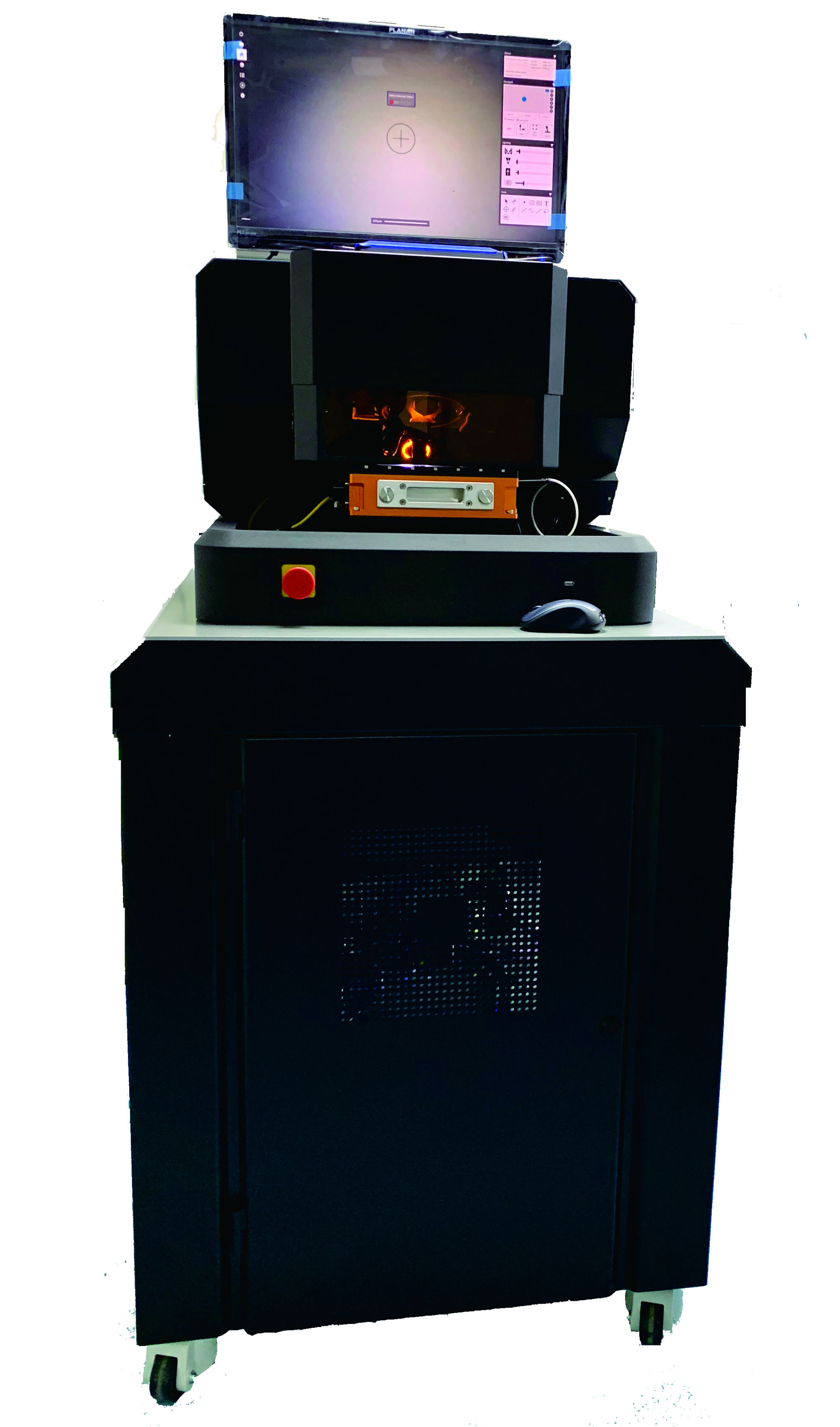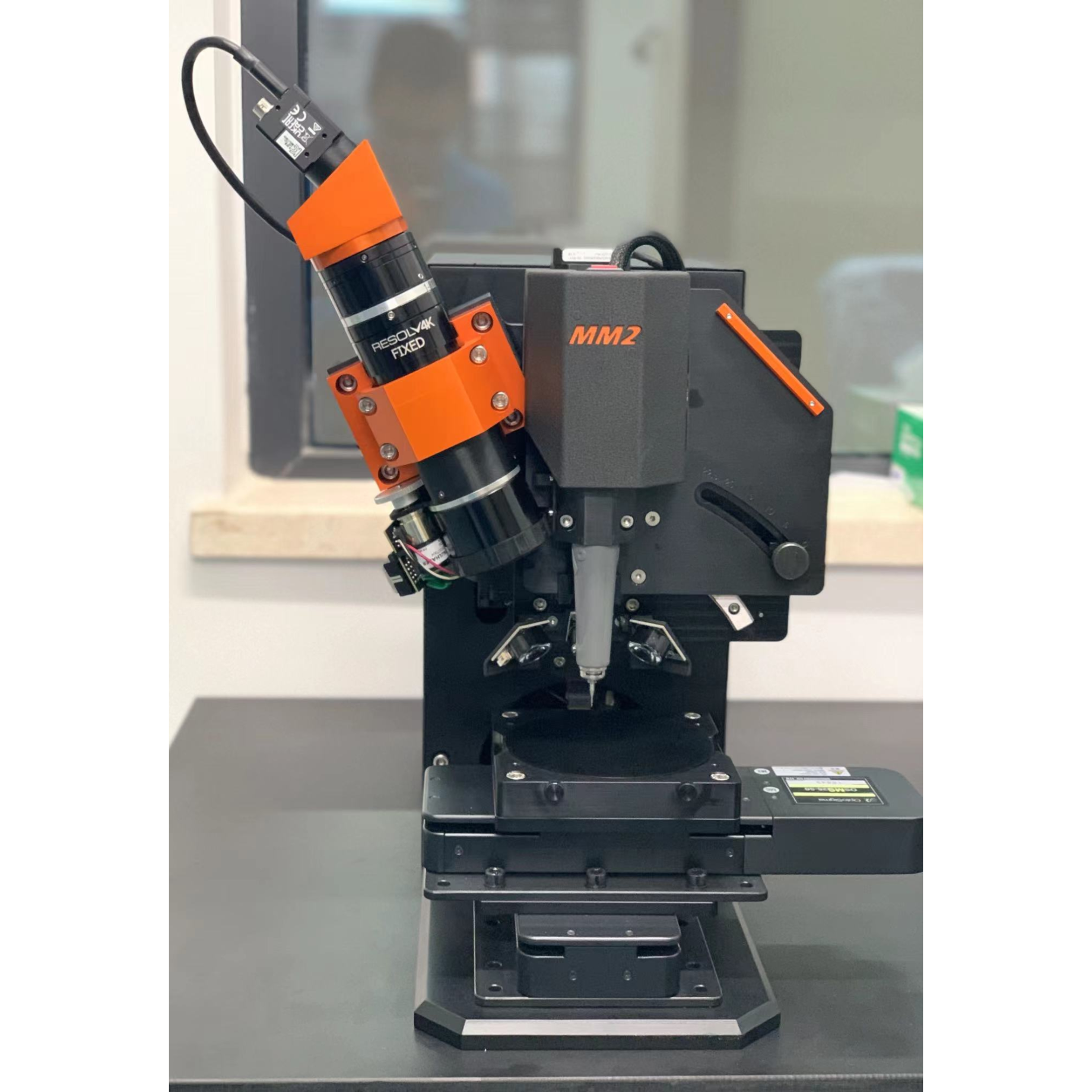方案详情
文
对苏鲁造山带超高压变质岩进行了氧同位素研究。目标样本包括深达200至4000米的各种岩性(主要是榴辉岩和片麻岩),岩性之间有五个连续的岩心段。结果显示矿物成分中的δ18O的值从10.41-9..63‰不等。榴辉岩和片麻岩频繁交替的岩层中,不同的δ18O值的变化是渐进的,与岩性无关。石英与其他矿物之间存在平衡和不平衡O同位素分馏现象。需要特别注意的是相邻样本之间δ18O值与距离之间的关系。结果表明对应于大陆碰撞期间产生的*流体流动性,不同岩性和相同岩性的O同位素在20 ~ 50cm的尺度上存在异质性。在掘出过程中,角闪石逆变质作用引起了部分矿物的矿物反应和O同位素间的不平衡。δ18O与岩相在榴辉岩和片麻岩接触处存在明显变化,也能反映不同岩相之间流体活动比较活跃。尽管逆行现象普遍存在,但逆行流体在稳定同位素组成中具有内部缓冲作用。逆行液起源于氘核,由结构羟基的减压析出液衍生而来。虽然局部外部流体在断层及岩性变化带存在,但是它仍以内部原始形式存在于被掘出的板岩中。角闪石相后退后也发生了流体流动,但只影响长石和云母的O同位素组成。前元形态学原岩推断异构δ18O值是由于不同程度的大陆碰撞之前大气水岩相互作用。δ18O值存在的最低深度可达3300米,大别苏禄造山带地表露头岩石有大面积δ18O残留,新元古代华南地块北缘至少有6.6万km3的超地壳岩石与大气水相互作用。
方案详情

CHEMICALGEOLOGYChemical Geology 242 (2007) 51-75www.elsevier.com/locate/chemgeo 52R.-X. Chen et al. / Chemical Geology 242 (2007) 51-75 INCLUDING ISOTOPE GEOSCIENCE Oxygen isotope geochemistry of ultrahigh-pressure metamorphicrocks from 200-4000 m core samples of the ChineseContinental Scientific Drilling Ren-Xu Chen, Yong-Fei Zheng, Bing Gong, Zi-Fu Zhao, Tian-Shan Gao, Bin Chen, Yuan-Bao Wu CAS Key Laboratory of Crust-Mantle Materials and Environments, School of Earth and Space Sciences, University of Science and Technology of China, Hefei 230026, China Received 23 August 2006; received in revised form 16 February 2007; accepted 3 March 2007 Editor: D. Rickard Abstract Oxygen isotope studies were carried out for ultrahigh-pressure metamorphic rocks from the main hole of the ChineseContinental Scientific Drilling in the Sulu orogen.The samples of interest include various types of lithology (mainly eclogite andgneiss) in a depth of 200 to 4000 m, containing five continuous core segments between contrasting lithologies. The results show alarge variation in 818o value from -10.41 to 9.63%o for constituent minerals. Distinct180 depletions are observed in the frequentlyalternated layers of eclogite and gneiss, in which the variations of 80 values are gradual, regardless of lithologies. Bothequilibrium and disequilibrium O isotope fractionations are observed between quartz and the other minerals. Special attention waspaid to the relationship between distance, petrography and 818o value of adjacent samples. The results show O isotope hetero-geneities between the different and same lithologies on scales of about 20 to 50 cm, corresponding to the maximum scales of fluidmobility during the continental collision. Amphibolite-facies retrograde metamorphism during exhumation caused mineralreactions and O isotope disequilibria between some of the minerals. Considerable changes occur in 80 and petrography at thecontact between eclogite and gneiss, suggesting that the contact between different lithologies is the most favorable place for fluidactivity. Despite the widespread retrogression, retrograde fluid was internally buffered in the stable isotope compositions. The1eretrograde fluid is of deuteric origin and thus was derived from the decompression exsolution of structural hydroxyl. Althoughlocally external fluids became available along fault zones and lithological layers, it still acted within the exhumed slabs withinternal origins. Fluid flow also took place after the amphibolite-facies retrogression, but it only affects the O isotopecompositionsof feldspar and mica. Premetamorphic protoliths are deduced to have heterogeneous 80 values due to varying degrees ofmeteoric water-rock interaction before continental collision. Minimum depth of the 18o depletion is up to 3300 m. Together withareal 8o depletion in surface outcropped rocks along the Dabie-Sulu orogenic belt, at least 66,000 km of supracrustal rocks wereinteracted with meteoric water along the northern margin of the South China Block during the Neoproterozoic.C 2007 Elsevier B.V. All rights reserved. Keywords: O isotope; Petrography; Eclogite; Gneiss; Aqueous fluid; Continental collision; UHP metamorphism; CCSD; Sulu orogen ( * Corresponding author. ) ( E-mail a ddress: y fz h e n g@us t c .e d u . cn ( Y.-F. Zheng). ) ( 0009-2541/$ - see front matter C 20 0 7 Elsevier B.V. All rights reserved.doi:1 0.1 0 16 /j .che mge o.2007. 03 . 0 08 ) 1. Introduction The Dabie-Sulu ultrahigh-pressure (UHP) metamor-phic belt in east-central China is the largest known UHPterrane in the world. Since findings of coesite anddiamond in metamorphic rocks from this region (e.g.,Okay et al., 1989; Wang et al., 1989; Xu et al., 1992), ithas attracted extensive interest from the geosciencecommunity (cf. Ernst and Liou, 1999; Jahn et al., 2003;Rumble et al., 2003; Zheng et al., 2003, and referencestherein). In order to understand the fluid regimes whichcan greatly assist in the development of formation andexhumation of UHP metamorphic terranes, many studieshave been made on stable isotope geochemistry of UHPmetamorphic rocks. Finding of anomalously low eIIHP eclr8l8ovalues of -11 to -4%o in the UHP eclogites and gneissesindicates exchange of meteoric water with their protolithsbefore the Triassic subduction (e.g., Yui et al., 1995;Zheng et al., 1996; Baker et al., 1997; Rumble and Yui,1998;Zheng et al., 1998, 1999; Fu et al., 1999; Zhenget al., 2001; Xiao et al., 2002; Fu et al., 2002,2003).Preservation of such low 8180 signatures indicates verylow fluid mobility during the bulk processes ofsubduction and exhumation of the continental crust (Fuet al., 2001; Zheng et al., 2003). These stable isotopestudies have been successfully used to characterizechemical geodynamics and fluid regime during continen-tal subduction and exhumation. As demonstrated byZheng et al. (2003), continent-continent collision is notonly characterized by fast subduction and fast exhumationof cold slabs with short-lived residence at mantle depths,but also its fluid regime is attributed to redistribution ofdeuteric water that attests significant activity during theexhumation with major derivation from decompressionexsolution of structural hydroxyl in nominally anhydrousminerals. 2004; Zhang et al., 2004; Xia et al., 2005; Katayama et al.,2006; Chen et al., 2007). During exhumation, due to anabrupt decrease in pressure, hydroxyl-bearing mineraldecomposition and hydroxyl exsolution would releasesignificant amounts of aqueous fluid, resulting inamphibolite-facies retrogression, formation of quartzveins in eclogites and even syn-exhumation magmatism(Zheng et al.2003; Li et al.2004). These petrological and geochemical studies of surfacesamples have not only provided important constraints onfluid activity during pre- through syn- to post-UHPmetamorphic phases, but also put forward a lot ofquestions: (1) how did water/rock interaction take placeat vertical depths within an UHP terrane? (2) how largevolumes of UHP rock have the 18O-depleted signature?(3) how continuous do mineral 818O values change at thetransition between different UHP lithologies? (4) onwhich scale can mineral O isotopes record fluid activityduring the continental collision? In fact, there is stilllimited knowledge about fluid behavior during exhuma-tion, especially about the quantitative scales of fluidactivity in different UHP lithologies. The Chinese Continental Scientific Drilling (CCSD)in the Dabie-Sulu UHP metamorphic belt provides anadvantageous and rare chance for collecting UHP rocksamples continuously from the subsurface (Xu et al.,1998). Major goals ofthe CCSD include: (1) revealing ofthe crustal structure of convergent plate boundaries, (2)providing constraints on crust-mantle interactions andmantle behavior during deep subduction of continentalcrust, and (3) investigating the variation of fluidcomposition with depth, the flow patterns and cyclingmechanisms, as well as changes of the fluid regime intime. O isotope variations through vertical sections from100 to 3000 m for CCSD main hole have beeninvestigated by Xiao et al. (2006) and Zhao et al.(2007), and the results show that meteoric water/rockinteraction has reached depths of at least 2700 m and theO isotope shows different behavior on different scales. This paper presents a combined study of petrographicobservation and O isotope analysis on selected samplesfrom 200 to 4000 m for the CCSD main hole, withparticular attention to the relationship between distance,petrography and 880 value of adjacent samples. Fivecontinuous core segments consisting of different UHPlithologies were investigated comprehensively in order toprovide geochemical constraints on fluid behavior duringthe continental collision. Compared with the previousstudies, the present study is not only an important accountofoxygen isotope geochemistry from the lower part of theCCSD core,but also the first demonstration of the mag-nitude of the ancient hydrothermal system that produced the famous premetamorphic 18O depletion in the Dabie-Sulu orogenic belt. 2. Geological setting and samples UHP metamorphic rocks outcropping in the Dabie-Sulu orogenic belt represent exhumed products of theTriassic subduction of the South China Block beneath theNorth China Block (e.g., Cong, 1996; Liou et al., 1996; Liet al., 1999; Zheng et al., 2005). The eastern part of theorogenic belt was displaced approximately 500 km ofleft-lateral strike-slip by the NE-trending Tan-Lu fault to the northeast from the Dabie orogen to form the Sulu orogen(Fig. 1). The latter is separated from the North ChinaBlock to northwest by the Wulian-Qingdao-Yantai Fault(WQYF), and the South China Block to southeast by theJiashan-Xiangshui Fault (JXF). The Sulu orogen can be divided into fault-boundedUHP and HP metamorphic zones (Xu et al., 2006). TheUHP zone consists mainly of eclogite, orthogneiss.paragneiss, amphibolite, garnet peridotite,pyroxenite,and marble. The eclogite is generally enclosed withingneissic rocks and marble as layers and blocks. Althoughamphibolite-facies overprinting is significant, evidence Fig. 1. Sketch map of geology in the Sulu orogen and the Donghai area, showing major lithotectonic units and the locations of outcrops and prepilotdrillhole of CCSD-PP1, CCSD-PP2 and the CCSD main hole (modified after Liu et al.,2001). (1) Quaternary; (2) Tertiary basalt; (3) Cretaceousbasin; (4) Cretaceous granite; (5) aegirine-bearing granitic gneiss; (6) amphibole-bearing granitic gneiss; (7) garnet-bearing granitic gneiss;(8) biotite-bearing granitic gneiss; (9) amphibole-bearing and biotite-bearing granitic gneiss; (10) epidote-bearing and biotite-bearing granitic gneiss;(11) supracrustal rocks, including paragneisses, kyanite-bearing and jadeite-bearing quartzite, and marble; (12) eclogite and ultramafic rocks;(13) ductile shear zone or fault; (14) drilling hole. NCB-North China Block; SCB--South China Block; WQYF-F_-Wulian-Qingdao-Yantai fault; JXF-Jiashan-Xiangshui fault. for UHP metamorphism has been recognized in coesite-bearing eclogite, schist, ultramafic rocks, and somegneisses (Zhang et al., 1995; Liou and Zhang, 1996; Yeet al., 2000; Liu et al., 2002, 2004a,b, 2005; Yang et al.,2003). Peak metamorphic conditions are defined bycoesite-bearing eclogites with temperature of 750 to850℃ and pressure of 2.5 to 4.5 GPa (e.g. Liou et al.,1998; Liu et al., 2004c). The HP zone is mainlycomposed of quartz-mica schist, chloritoid-kyanite-mica-quartz schist, marble, and rare blueschist (Zhanget al., 1995; Liu et al.,2004c). The main hole (MH) of Chinese ContinentalScientific Drilling Project (CCSD), with a depth up to5158.8 m, is located at the southwestern part ofthe Suluorogen (N34°25',E118°40'), about 17 km southwest ofDonghai City (Fig. 1). This area is underlain mainly byparagneiss, orthogneiss and supercrustal rocks mostlywith Neoproterozoic protolith ages (Liu et al., 2004a,b;Zheng et al., 2004), which were intruded by Cretaceousgranite and unconformably overlain by Quaternarysedimentary cover (Fig. 1). Finding of coesite in the gneiss and eclogite in this area, as well as finding ofmicro-diamond in the eclogite from Maobei (Xu et al.,2003, 2005) demonstrate that the high-grade rocks inthis area were subducted to mantle depths to undergoUHP metamorphism. Metamorphic rocks recovered from CCSD-MH arevarious types of gneiss, eclogite, amphibolite, marble andperidotite. From 0 to 100 m, only rock cuttings werecollected. The section from 100 to 2050 m has a corerecovery of ~80%. Eclogite and orthogneiss are theprincipal lithological types; other rocks include para-gneiss, ultramafic rock and rarely, schist and quartzite.The section from 2050 to 4000 m is mainly composed oforthogneiss and paragneiss, with minor amounts ofeclogite and amphibolite occurring as interlayers(Fig.2). Coesite was found as inclusions within zirconsr·1from both gneiss and eclogite (Liu et al., 2001, 2002,2004a,b, 2005, Zhang et al., 2006a), demonstrating thatboth eclogite and gneiss were subjected to in situ UHPmetamorphism.P-Testimates of 675 to 815C and 3.1 to4.4 GPa were obtained for eclogite at depths of 0 to Fig. 2. Lithological profile of CCSD main hole from depths of 0 to 4000 m (revised after Liu et al., 2005). 2050 m from CCSD-MH (Zhang et al., 2006b). SHRIMPU-Pb dating for coesite-bearing domains of zircons fromthe CCSD gneisses yields ages of 226 to 234 Ma for theUHP metamorphic event and about 750 to 780 Ma for thehost metaigneous protolith (Liu and Xu, 2004; Liu et al.,2004a,b). These dates are consistent with known resultsfrom multi-method geochronological studies of surface-exposed UHP metamorphic rocks along the Dabie-Suluorogenic belt (e.g. Ames et al.,1996; Hacker et al., 1998;Li et al., 1999,2000; Hacker et al., 2000; Zheng et al.,2003, 2004; Li et al., 2004). A combined study ofpetrography and geochronology for the CCSD-MHeclogite also reveals occurrence of a HP eclogite-faciesrecrystallization phase at 216±3 Ma (Zhao et al., 2006). After general inspection of the CCSD-MH cores, weselected 87 samples for petrographic and O isotopeinvestigations. The sampling depths range from 220 to4000 m (Fig. 2). They include 51 samples from fivecontinuous core segments, with particular attention to thetransitions between eclogite, amphibolite and gneiss. Theother 36 samples are sporadic at different depths. The fivecontinuous core segments are composed of interlayeredamphibolite and eclogite, gneiss and eclogite,eclogite andschist, gneiss, amphibolite and eclogite, and eclogite andamphibolite, respectively. They are from depths of (1)1637.23 to 1640.55 m, (2) 1921.64 to 1924.03 m, (3)2710.21 to 2711.66 m, (4) 3296.90 to 3300.20 m, and (5)3585.10 to 3586.42 m, respectively, named as the first,second, third, fourth and fifth core segments. Lithologies,mineral assemblages, and depths of samples are summa-rized in Table 1. A general description of petrology for theCCSD-MH cores (especially for 0 to 2050 m) have beenpresented by Liu et al.(2004a,2005), Su et al.(2005) andZhang et al. (2006a,b). Fig. 3 illustrates the relationshipbetween different lithologies in the fourth core segment. 3. Analytical methods Minerals were separated for isotopic analyses. Aftercrushing, a shaking bed was used to separate heavyminerals, followed by magnetic separation using amagnetic separator, and then purified by hand pickingunder binocular microscopes.All mineral separates usedfor O isotope analyses are grained in sizes of 40 to 60 um. Oxygen isotope analysis was accomplished formineral separates by the laser fluorination techniquesat University of Science and Technology of China inHefei. A 25 W CO, laser MIR-10 was used: its emissionwavelength is 10.6 um, which lies in the infrareddomain, and can thus be well absorbed by O-bearingcompounds; its power can be adjusted in the range of0 to100%, which is very important during sample analysis; and the diameter of the laser beam can be adjusted from100 to 1820 um. Minerals weighing about 1.5 to 2.0 mgwere reacted with BrFs under vacuum conditions.Obtained O2 was directly transferred to a mass spec-trometer for O isotope ratio measurement.18o/6Oratioswere measured in a Finnigan Delta XP mass spectrom-eter and reported in the 8o notation relative to theVSMOW standard. A number of replicate analyses gavethe reproducibility better than ±0.1% (Zheng et al.2002). Three international standards and two nationalstandard of China were used during the laser fluorinationanalyses: 8180=5.8%for UWG-2 garnet (Valley et al.,1995); 8180=5.2% for SCO-1 olivine (Eiler et al.,1996); 8l80=10.0% for 91500 zircon (Zheng et al.,2004);8180=11.1%o for the National Standard of ChinaGBW04409 quartz (Zheng et al., 1998);8180=-1.7%for the National Standard of China GBW04410 quartz. Oxygen isotope composition of calcite was analyzedby Gasbench-MS online technique at University ofScience and Technology of China in Hefei. This is anintegrated procedure by using a Finnigan Gasbench IIand a Finnigan MAT-253 mass spectrometer (MS) viaopen split in a Finnigan Conflo III interface. CO2 fromcalcite was extracted by reaction with phosphoric acid at72C in the Gasbench. Then obtained CO2 was analyzedin the mass spectrometer in a continuous flow mode.The National Standard of China GBW04416 with8180=18.96%o was used as the reference material. Theresults were reported in the 818o notation relative to theVSMOW standard. The reproducibility of replicateanalyses is better than ±0.2%o for 8 O values. Assumingpreservation of O isotope equilibration at the scale ofsample measurement, apparent temperatures of quartz-mineral pairs are calculated with 2o uncertainties usingthe fractionation equations calibrated by Zheng (1991,1993a,b). As illustrated by Zheng et al. (1998, 1999),similar temperatures can be obtained if calibrations ofMatthews (1994) are applied. 4. Results 4.1. Petrography Lithologies and mineral assemblages for the coresamples are shown in Table 1 and Fig 4. Mineralcomposition of the eclogite from CCSD-MH can varyfrom sample to sample. Petrographic studies indicate fourtypes of eclogite according to the content of minerals(Table1): quartz-rich eclogite (quartz> 10 vol.%), rutile-rich eclogite (rutile in 5-10 vol.%), phengite- and/orkyanite-rich eclogite (phengite+kyanite>10 vol%) andnormal eclogite. Similar subdivision was also made for Sample Rock type Depth(m) Qz Gt Omp Sym Pl Kfs Mt Mus Ep Bt Amp Rt Ilm Other Ap Zr Vein 02-648.9 Eclogite 648.9 10-15 35 10 20-30 5-10 2 Ttn(T) T T 02-652 Eclogite 652.0 30 60-70 <5 4 <2 T Cc 02-700 Eclogite 700.0 5-10 40 40-50 <5 5 <2 T T Fel 02-704 Eclogite 704.0 T 60 40 T T T 02-738.7 Gneiss 738.7 45-50 30 5 10, Chl:<5 5 02-739.5 Gneiss 739.5 20-25 30 5-10 10-20, Chl:5 10-15 T T 02-927 Gneiss 927.0 35-40 5 20-30 10-15 1-2 20 T Ttn(T) T T 02-928 Gneiss 928.0 25 30-35 5 <5 10 25 T T 04A-1 Eclogite 222.15 5 45 30-40 5-10 1-2 T T T T 04A-2 Eclogite 347.65 15-20 50 20-25 <5 5 T T T 04A-3 Gneiss 367.00 20-30 <2 35 5 10-15, Chl:4 10-25 T T 04A-4 Eclogite 572.00 30-35 50-60 T T 04A-5 Eclogite 1067.00 5-10 20 5-10 30-40 T 5-10 2-3 T Ky(T) T T 04A-6 Gneiss 1170.30 30-35 25 30-40 T 3-5 T T 04A-7 Gneiss 1262.39 25-40 20 20-25 10-15, Chl:5 T T 04A-8 Gneiss 1390.60 30-40 30-40 5 T 5-10 Ttn(T) T T 04A-9 Schist 1508.21 10-15 30-40 30-40 Ttn(T) T T 04A-10 Eclogite 1644.70 T 20 60 5-10 12 1-2 T T T 04A-11 Eclogite 1645.65 T 40 30-40 5-15 T T T T Cc, Fel 04A-12 Eclogite 1756.03 T 30 60 <5 5 1-2 T T Fel 04A-13 Gneiss 1795.00 30-40 27 35 2 T T Cc, Fel 04C-1A Gneiss 1637.23 40 5-10 30 T 5-10 5,Chl:3 T T 05B-1aA Eclogite 2710.21 10-15 30-35 <5 <2 8, Chl:2 2-5 Ttn(T) T T 05B-1aC Eclogite 2710.41 10-15 20-30 <2 30-35 <5 10, Chl:3 2 1 Ttn(T) T T 05B-1b Eclogite 2710.53 5-10 20-25 <2 40-45 2-5 5 10-15 5 5 2 Ttn(T) T T 05B-1cA Eclogite 2710.61 5-10 15-20 T 50-55 1-2 T T 5 <5 5 T T T 05B-2A Eclogite 2710.74 <5 10-20 T 40-45 5-10 1 5 1 15-20 2-3 T Ttn(T) T T Cc, Fel 05B-3 Eclogite 2710.84 5 20 <3 30-40 <5 2-5 15-20 T T T Cc, Fel 05B-4A Eclogite 2711.07 5-15 10-15 <2 40-50 T 15, Chl:5 10 <2 T T 05B-5A Schist 2711.32 20-30 20 5 10 20-30 T T Cc,Fel 05B-6 Schist 2711.46 25 25 5-10 10-15, Chl:7 20-30 T T 05B-7 Schist 2711.54 30 10-20 5-10 18, Chl:5 20-25 T T Fel 05B-8 Schist 2711.66 30 20 5 5-10 30-40 T T Fel 05C-1A Gneiss 3296.90 40 25 35 2-5 T(Chl) T T 05C-2 Gneiss 3297.02 10-20 30 40 Cc(5) T T Cc 05C-3 Gneiss 3297.20 35 T 25 30 <2 5 5, Chl:3 T T Cc 05C-4A Gneiss 3297.42 40 30 20 5 5 T T Cc 05C-4C Amphibolite 3297.57 <5 10-15 <5 5-10 70-80 T T Cc 05C-5A Amphibolite 3297.72 20 5 5-10,Chl:4 70 T T Cc, Fel 05C-6A Amphibolite 3297.85 <5 <15 <5 10-15, Chl:5 65 T T Cc<5 05C-7A Amphibolite 3298.00 25 10-15, Chl:6 50 <5 1-2 Ttn(T) T T Cc 05C-8 Eclogite 3299.73 T 20-30 <5 60 <5 5 2 T T 05C-9 Eclogite 3299.80 <5 10-15 <2 70-80 2-5 2 Ttn(T) T T Cc, Fel 05C-10 Eclogite 3300.00 <2 30-40 <5 40-50 <5 T Abbreviations: Qz-quartz, Pl-plagioclase, Kfs-potassic feldspar, Gt-garnet, Omp--omphacite,Mus-muscovite, Ep-epidote, Mt-magnetite, Btbiotite, Amp-amphibole, Rt-rutile, Ky-kyanite, Chl-chlorite,Ilm-ilmenite, Ttn-titanite, Cc-calcite, Sym—symplectite, Ap-apatite, Zr-zircon, Fel-felsic vein, T-trace. CCSD-MH core samples (Su et al., 2005; Zhang et al.,2006a,b). General paragenesis of the eclogites is garnet+omphacite+rutile±phengite±kyanite±quartz±plagioclase±biotite. The minerals show variabledegrees of pervasively retrograded texture (Fig. 4a, band c). Rutile occurs in all the investigated eclogites; insome samples, it is rimmed by ilmenite and/or titanite.Omphacite is generally replaced by amphibole and sodicplagioclase symplectite, and garnet by amphibole andplagioclase symplectite (Fig. 4b). Felsic and calcite veinswere observed in some of the samples (Fig.4c). The gneiss mainly consists of quartz+plagioclase±biotite±epidote±K-feldspar±phengite±rutile±amphi-bole±garnet±magnetite (Fig. 4d and e). A few of thegneisses are rich in biotite and amphibole but poor infelsic minerals relative to the most gneisses. They arerenamed as the schist, but discussed geochemicallywithin the gneiss category. In some samples, biotite ispartially replaced by chlorite. Major mineral assem-blages record amphibolite-facies overprinting. Butoccurrences of relict garnet in some gneisses and mineralinclusions (e.g., coesite) in zircon from the lithologyindicates that it was subjected to UHP metamorphismtogether with the enclosed eclogite (Liuoonsy et al., 2004a,b,2005). Felsic andcalcite veins are found in some samples(Fig. 4f). The amphibolite is generally composed of amphi-bole, quartz, plagioclase, apatite, epidote, biotite andrutile (Fig. 4g), with abundant symplectite after the primary omphacite and large amounts of residual garnetin some of the samples. Thus it may be a product ofretrograded eclogite. Felsic and calcite veins are foundin some samples (Fig. 4h). The five continuous core segments are composed ofdifferent lithologies (Figs. 3 and 4). Contacts betweenthe different lithologies are sharp (Fig. 3), indicating thatthey are original bedding prior to the UHP metamor-phism. Previous studies of tectonics (Xu et al., 2006), Oisotopes (Xiao et al., 2006; Zhao et al., 2007), petrologyand geochemistry (e.g., Zhang et al., 2006b), andgeochronology (Liu et al., 2004a,b) have also demon-strated that the eclogite and gneiss were subjected to insitu UHP metamorphism. Table 1 presents a detailedoutline of lithologies and mineral assemblages for thefive core segments. The first core segment 04C and thefourth core segment 05C consist of a transition fromgneiss, amphibolite to eclogite. Degree of retrogrademetamorphism increases with decreasing distance fromthe contact between eclogite and gneiss. Thissiisindicated by not only the amphibolite layer betweeneclogite and gneiss, but also the amount of symplectiteafter omphacite and garnet (Table 1). For the third coresegment 05B, there is no amphibolite between eclogiteand schist, but the eclogites adjacent to the schisthave larger extent of retrogression. This is indicated bythe observation that more amphibole grains in sym-plectite after omphacite occurs in the eclogite adjacentto gneiss. For the fifth core segment 05D that consists of a transition between gneiss and amphibolite, a felsicvein of about 3 cm length occurs as an interlayerbetween them. Calcite was commonly observed to occuras matrix and/or vein in the gneiss and amphibolite. The O isotope compositions of mineral separates fromeclogite, amphibolite, and gneiss are listed in Table 2. The Fig. 4. Microphotographs of eclogite, gneiss and amphibolite from the CCSD main hole. (a) Eclogite (02-652,652.00 m), containing garnet,omphacite, rutile. (b) Eclogite (05A-10A, 2768.33 m), containing garnet, omphacite, amphibole, quartz, rutile. Most of the omphacite was replacedby symplectite, and garnet is commonly rimmed by symplectite. (c) Eclogite (04A-11,1645.65 m), consistingof garnet, omphacite, with minorphengite and rutile. Felsic and calcite vein was found in the sample. (d) Gneiss (02-927, 927.00 m), consisting of quartz, plagioclase, garnet, biotite,epidote, muscovite and K-feldspar. Biotite is partially replaced by chlorite. (e) Gneiss (04A-8, 1390.60 m), containing quartz, plagioclase, K-feldspar,biotite, with minor magnetite. (f) Gneiss (02-738.7, 738.7 m), consisting of quartz, plagioclase and biotite. Calcite vein was found in the sample(g) Amphibolite (05A-8A, 2888.58 m), containing amphibole, plagioclase, quartz, epidote and biotite. Biotite was partially replaced by chlorite.(h) Amphibolite (05A-2A, 3963.23 m), consisting of amphibole, K-feldspar and quartz. Calcite vein was found cutting through the amphibole.Mineral abbreviations: Gt =garnet, Omp=omphacite, Phg=phengite, Sym=symplectite, Qz= quartz, Rt=rutile, Ilm= ilmenite, Ttn =titanite,Am= amphibole, Bt =biotite, Pl=plagioclase, Kfs =K-feldspar, Ep =Epidote, Mus = muscovite, Mt = magnetite, Cc=Calcite. 05B-1aC Eclogite 2710.41 1.99 1.31 -2.26 -1.70 -3.22 -6.30 -1.32 05B-1b Eclogite 2710.53 1.69 -0.68 -2.67 -0.59 -3.42 -5.35 -2.04 05B-1cA Eclogite 2710.61 2.51 0.54 -1.25 -1.53 -3.10 -5.75 -2.19 05B-2A Eclogite 2710.74 3.77 1.79 0.76 0.33 0.55 -3.35 -3.07 0.56 05B-3 Eclogite 2710.84 2.78 1.67 2.87 -1.46 -0.68 -3.66 -3.39 -0.55 05B-4A Eclogite 2711.07 2.64 -1.37 -3.26 -5.60 -1.15 05B-5A Schist 2711.32 2.78 -0.37 -0.91 -3.32 -1.52 -0.15 05B-6 Schist 2711.46 2.11 0.77 -1.60 -3.16 -1.73 -0.21 05B-7 Schist 2711.54 1.87 1.14 -2.14 -3.63 -2.43 -0.52 05B-8 Schist 2711.66 1.74 0.59 -1.62 3.45 -2.25 0.69 05C-1A Gneiss 3296.90 8.12 5.61 5.37 -0.28 6.52 05C-2 Gneiss 3297.02 8.75 6.18 5.47 6.34 05C-3 Gneiss 3297.20 7.77 5.19 5.34 5.31 6.35 05C-4A Gneiss 3297.42 7.41 5.19 5.69 4.08 6.34 05C-4C Amphibolite 3297.57 4.54 2.18 4.01 4.21 05C-5A Amphibolite 3297.72 3.69 3.18 4,28 4,05 05C-6A Amphibolite 3297.85 3.81 3.11 4.57 7.40 (Cc) 4.27 05C-7A Amphibolite 3298.00 4.21 3.09 4.88 1.97 4.32 05C-8 Eclogite 3299.73 5.25 3.60 5.93 1.61 4.10 05C-9 Eclogite 3299.80 9.30 5.31 3.75 1.78 4.06 05C-10 Eclogite 3300.00 3.54 5.13 6.81 3.79 1.55 4.33 05C-11A Eclogite 3300.20 4.78 5.57 2.97 1.99 4,26 05D-1A Gneiss 3585.10 8.46 5.67 4.44 1.03 -3.14 5.62 05D-2A Gneiss 3585.23 8.23 5.03 4.49 5.65 3.37 5.63 05D-5A Amphibolite 3585.66 2.95 (Cc) 05D-6A Amphibolite 3585.86 5.59 2.92 1.33 4.76 (Cc) 1.65 05D-7A Amphibolite 3586.07 4.26 1.93 0.91 4.52 (Cc) 1.11 05D-8A Amphibolite 3586.21 2.36 3.73 3.45 05D-8C 05A-15A Amphibolite Eclogite 3586.42 2007.49 8.92 4.65 3.95 5.69 2.90 3.66 1.03 4.20 (Cc) 3.51 4.94 05A-14 Gneiss 2076.75 7.93 5.17 5.80 Abbreviations: Qz—quartz, Pl—plagioclase, Kfs-potassic feldspar, Gt-garnet, Omp-omphacite, Mus-muscovite, Ep-epidote, Mt-magnetite, Bt-biotite, Hb-hornblende, Rt-rutile, Ky-kyanite, Chl-chlorite,Ttn--titanite, Cc-calcite, WR- -whole-rock (estimates 8 8o value from modal abundance). results show large variations in O isotope ratios (Figs. 5and 6). The eclogite has 8180 values of -3.32 to 7.52%for garnet, -2.55 to 5.84%o for omphacite, -0.45 to9.30%o for quartz and -2.79 to 6.81%o for muscovite. Theamphibolite has 8180 values of -4.53 to 5.23%o foramphibole, -3.26 to 6.75%o for plagioclase and -0.19 to9.22% for quartz. 8O values of minerals from the gneissvary from -2.69 to 9.63%o for quartz,-0.74 to 8.11%o forplagioclase and -7.83 to 3.53 for biotite. Based onmineral 8180 values and modal abundance, whole-rock8180 values are estimated to be about-2.58 to 5.86%,-3.47 to 5.77%o and -2.25 to 8.40%o for the eclogite,amphibolite and gneiss, respectively (Table 2). All the investigated samples, can be di..18vi1ded8 into twogroups according to their bulk 818O values:18O-depletedrocks (8180 as low as -3.7%o for garnet) and normal880 rocks with 880>+5.6%o. An O isotope profilefrom 0 to 4000 m for CCSD-MH is illustrated in Fig. 5. Itappears that the O isotope compositions vary with spatialdistribution, and mineral 818o values are significantlyheterogeneous. In particular, abrupt changes in 8l8ooccur on scales of about 100 m.180 depletion isobserved down to 1600 m, from 2300 to 2700 m, about2900 m, and 3200 to 3300 m, respectively, regardless oflithology. In contrast, the samples from 1650 to 2300 mand 3300 to 4000 m have the normal 818o valueswithout 0 depletion. The lowest 80 values occur atdepths of 900 to 1100 m, 2500 to 2600 m and 2900 m,respectively, close to the orthogneiss layers. Figs. 7,8, 9, 10 and 11 show five O isotope profiles ofminerals in the eclogite, amphibolite and gneiss from thefirst, second, third, fourth and fifth core segments,respectively. It appears that the O isotope compositionsvary with spatial distribution, the eclogite and/or gneissfrom the first, second, fourth, fifth core segments have thenormal or slightly reduced 818o values, whereas thosefrom the third core segment show significantly reduced8 0 values. O isotope heterogeneity on different scalescan be investigated by looking at the relationship betweendistance, petrography and 818O value of adjacent samples. For the first core segment 04C, the amphibolite layerseparates the eclogite from the gneiss. Because of thedifficulty in recovering mineral separates from theamphibolite, only few minerals were available for the Oisotope analysis. The results show that the eclogite has880 values of 4.83 to 5.35%o for garnet, 5.36 to 5.73%for omphacite, 8.71 to 9.24%o for quartz, 5.43 to 5.99%ofor muscovite, and 0.71 to 1.17%o for rutile. The gneisshas 8l80 values of 9.30 to 9.43% for quartz, 7.33 to8.11%o for plagioclase, 7.55 to 8.06%o for K-feldspar, 5.45to 5.74%o for muscovite, -0.65 to 1.44 for magnetite. Asshown by Fig. 7, 8180 values for quartz, feldspar and Fig. 5. Oxygen isotopic compositions vs. depths of CCSD-MH coresamples in the Sulu orogen (for clarity not all measured values arepresented in this figure). mica are almost concordant with each other for gneisses04C-1A to 04C-3A at depths of 1637.23 to 1637.83 m,and eclogites 04C-8A to 04C-12A at depths of 1638.67 to1640.15 m are relatively homogeneous in their mineral88o values (Table 2). This suggests that the mineral 818ovalues in the eclogite and gneiss are homogeneous onscales of 48 cm and 148 cm, respectively. The gneiss hassimilar 88o values for quartz and muscovite to theeclogite, whereas the amphibolite has significantly low88o values for muscovite but high 880 values forgarnet. A high 8 0 value of 7.52%o for garnet occurs inamphibolite 04C-6A that is 49 cm away from adjacenteclogite 04C-8A. Magnetite from the gneiss showsvariable 8180 values from -0.65 to 1.44%o on scales of24 to 36 cm. All of these suggest that the 8180 hetero-geneity can occur on scales of 22 to 49 cm in this coresegment. For the second core segment 04B, the eclogite has880 values of 4.86 to 5.32% for garnet, 5.18 to 5.84%o 3.88 to 5.23%o for amphibole and 1.07 to 1.22%o for rutile.Except for amphibole, the other mineral 818o values arerelatively homogeneous in both eclogite and amphibolite, Fig. 6. Plots of the O isotope composition of quartz vs. coexisting minerals in eclogites and gneisses from the CCSD main hole. Fractionation lines atdifferent temperatures are drawn by applying the theoretical calibrations of Zheng (1991, 1993a,b). for omphacite, 5.65 to 6.68%o for muscovite, and 1.45 to2.08%o for rutile. 818O values for single minerals in theamphibolite range from 8.20 to 8.75%o for K-feldspar, Fig. 7. Profiles of 8 o values in the first core segment 04C of CCSD-MH. respectively. The minerals from the eclogite show asimilar 8 8O variation except muscovite. The eclogite andamphibolite have similar 818o values for feldspar. Incontrast, the rutile from the amphibolite has lower 818ovalues than those from the eclogite. Similarly, theamphibole from the amphibolite has lower 880 valuesthan omphacite from the eclogite, suggesting that aqueousfluid for amphibolite-facies retrogression was depleted ino relative to the precursor omphacite. As shown byFig. 8, amphibole from amphibolite 04B-3A at a depth of1922.30 m has a 8180 value of 5.23%o, whereas amphi-bole from amphibolite 04B-4A at a depth of 1922.40 mhas a 8180 value of 3.88% (Table 2). Amphibole from theadjacent amphibolites has higher or lower 818O values of~4.5%o (not only 04B-1A and 04B-2A at depths of1921.64 and 1921.79 m, but also 04B-5A at depth of1922.89 m). Thus a 8180 difference of 1.35%o occurs inamphibole on scales of 20 to 51 cm. For the third core segment 05B, the eclogite has 88ovalues of-2.67 to 0.76%o for garnet, -1.70 to 0.33%o for Fig. 9. Profiles of 88o values in the third core segment 05C ofCCSD-MH. omphacite, 1.69 to 3.77%o for quartz, -1.53 to 0.55%ofor muscovite,-0.68 to 1.79%o for plagioclase,-3.66 to-2.82%o for biotite, and-6.30to-3.07%o for rutile. Theschist has 8180 values of 1.74 to 2.78% for quartz,-0.37 to 1.14%o for plagioclase, -2.14 to -0.91%o forepidote,-2.43 to-1.52%o for amphibole, and -3.63 to-3.16%o for biotite. As illustrated by Fig. 9, except forbiotite, both eclogite and schist are significantly0heterogeneous in mineral 818o values. This is indicatedby not only a large88O difference between eclogite andschist, but also variations in 8180 among eclogite andschist. For quartz, two samples ofeclogite 05B-1aA and05B-1aC away from the contact have relatively homo-geneous 8 0 values of 1.99 to 2.05%o; three samples ofeclogite 05B-1b, 05B-1cA and 05B-2A show slightincreases in 8o value from 1.69 to 3.77%; twosamples of eclogite 05B-3 and 05B-4A and one sampleof schist 05B-5A have homogeneous 8180 values of2.51 to 2.78%o; three samples of schist 05B-6,05B-7 and05B-8 show relatively homogeneous 818o values of 1.74 to 2.11%o. As illustrated in Fig. 8, however,eclogites 05B-1b, 05B-1cA, 05B-2A and 05B-3 atdepths of 2710.53 to 2710.84 m show variable 8180values of -2.67 to 0.76%o for garnet on a scale of 31 cm(Table 2). The similar-scale 81O variations also occur inomphacite, rutile, muscovite quartz and plagioclase.These 80 variations occur in the interior of the eclogitethat is away from the contact, suggesting a fracturecontrol of 818oheterogeneity. For the fourth core segment 05C, the amphibolite layerseparates the eclogite from the gneiss. The gneiss has8180 values of 7.41 to 8.75% for quartz, 5.19 to 6.18%for plagioclase, and 5.34 to 5.69%o for K-feldspar. Theamphibolite has 88o values of 4.01 to 4.88% foramphibole, 3.69 to 4.54%o for plagioclase, and 2.18 to3.18%o for biotite. The eclogite has 8 80 values of 5.13 to5.57% for garnet, 3.60 to 3.75%o for omphacite, and 1.55to 1.99%o for rutile. As illustrated by Fig. 10, the gneissexhibits a slight decrease in 8 o values for quartz,plagioclase and muscovite when moving toward thecontact between gneiss and amphibolite at depths of3296.90 to 3297.42 m. Similarly, the amphibolite alsoshows a progressive decrease in mineral 8 o valuestoward the contact between amphibolite and gneiss atdepths of3297.57 to 3298.00 m. Biotite from amphibolite05C-4C at 3297.57 m has a 8180 value of 2.18%o, whichis significantly lower than 8180 values of 3.09 to 3.18%for amphibolites 05C-5A,05C-6A and 05C-7A at depthsof 3297.72 to3298.00 (Table 2). About 1.0% differenceoccurs in biotite on a scale of 15 m (Fig. 9). Both amphi-bole and plagioclase from the amphibolite have lower80 values than garnet from the eclogite, suggesting thataqueous fluid for amphibolite-facies retrogression wasdepleted in 0 relative to the precursor omphacite andgarnet. The eclogites are relatively homogeneous in88ovalues for rutile, omphacite and garnet, but heterogeneousfor biotite, muscovite and quartz on scales of20 to 27 cm For the fifth core segment 05D, a felsic vein separatesthe amphibolite from the gneiss. Two samples of thegneiss with a distance of 13 m (05D-1A and 05D-2A,respectively, at depths of 3585.10 m and 3585.23 m)have similar 880 values of 8.46%o and 8.23%o forquartz and 4.44o and 4.49%) for K-feldspar.Amphibole from amphibolites 05D-6A and 05D-7A(at depths of 3585.86 m and 3586.07 m) adjacent to afelsic vein has8180 values of 0.91 to 1.33%o,significantly lower than 3.66 to 3.73%o for amphibolites05D-8A and 05D-8C (3586.21 m and 3586.42 m) awayfrom the vein. About 2.33 to 2.82 % differences in 818Ovalues occur in amphibole on a scale of 14 cm (Fig. 10).For biotite, amphibolite 05D-7A and 05D-8A have818o values of 1.93 to 2.36% lower than 05D-6A and 05D-8C which have 8180 values of 2.90 to 2.92%suggesting heterogeneous 80 distribution in biotiteon a scale of 21 cm. For calcite, three samples ofamphibolite 05D-6A, 05D-7A and 05D-8C away fromthe felsic vein have relatively homogeneous 8 0 valuesof 4.20 to 4.76%o, and one sample of amphibolite 05D-5A adjacent to the vein has a significantly lower 8l8ovalue of 2.95%o. A 8180 difference of 1.81%ooccurs incalcite between amphibolites 05D-5A and 05D-6A at adistance of 20 m. Quartz and feldspar from the amphi-bolite have lower 8180 values than those from thegneiss (Fig. 11). As illustrated in Fig. 6, the mineral-pair O isotopefractionations are in both equilibrium and disequilibriumin the eclogite, amphibolite and gneiss. The temperatureerrors are estimated to be about 30 to 50°C in terms of818othe analytical uncertainties in mineral 8 0 determina-tion and fractionation curve calibration. The mineral-pairtemperatures span a wide range and some of them are toclow to represent UHP metamorphic conditions (Table 3). Except for eclogites 04A-2 and 05C-11A, neverthe-less, O isotope geothermometry for quartz-garnet pairsfrom the eclogite yields temperatures of 560 to 785 ℃(Table 3). They are close to petrological temperatures of675 to 815°C responsible for eclogite-facies metamor-phic conditions (Zhang et al., 2006b). This indicatesattainment and preservation of O isotope equilibriumbetween quartz and garnet at eclogite-facies conditions.On the other hand, quartz-omphacite, quartz-phengiteand quartz-rutile pairs from the eclogite yield tempera-tures of about 300 to 780 °C, 380 to 665 °℃ and 400 to535C (Table 3), respectively (except eclogites 04A-2and 05C-11A). These are differentially lower than thetemperature of the eclogite-facies metamorphism, sug-gesting the effect of retrograde isotopic exchange during Fig. 11. Profiles of 8o values in the fifth core segment 05D ofCCSD-MH. Table 3Oxygen isotope temperature for quartz-mineral pairs from CCSD-MH (in°C) * Sample No. Rock type Depth (m) Qz-Gt Qz-Omp Qz-Pl Qz-Kfs Qz-Bt Qz-Mus Qz-Rt Qz-Hb Qz-Ep Qz-Chl Qz-Ky Qz-Mt Qz-Ttn 02-648.9 Eclogite 648.90 620 555 515 02-738.7 Gneiss 738.70 490 470 02-739.5 Gneiss 739.50 2105 490 435 02-927 Gneiss 927.00 630 370 1350 1800 370 405 02-928 Gneiss 928.00 400 435 04A-1 Eclogite 222.15 785 560 450 440 04A-2 Eclogite 347.65 180 100 190 04A-3 Gneiss 367.00 615 410 470 460 04A-5 Eclogite 1067.00 795 780 650 415 450 580 04A-6 Gneiss 1170.30 725 1100 490 460 04A-7 Gneiss 1262.39 440 540 04A-8 Gneiss 1390.60 495 340 535 580 04A-11 Eclogite 1645.65 595 440 660 425 04C-1A Gneiss 1637.23 720 590 230 430 420 04C-2A Gneiss 1637.47 630 460 410 165 530 04C-3A Gneiss 1637.83 460 420 390 440 04C-5A Amphibolite 1638.05 130 410 04C-9A Eclogite 1638.85 680 505 525 405 04C-10A Eclogite 1639.02 630 590 480 420 04C-12A Eclogite 1640.15 560 500 480 405 04B-7bA Eclogite 1923.83 720 625 540 510 590 05B-1aA Eclogite 2710.21 720 505 395 470 470 420 05B-1aC Eclogite 2710.41 580 480 1100 440 400 05B-1b Eclogite 2710.53 565 400 445 665 470 05B-1cA Eclogite 2710.61 640 490 400 380 400 05B-2A 2710.74 770 515 490 305 490 480 Eclogite 05B-3 Eclogite 2710.84 580 510 800 345 535 05B-4A Eclogite 2711.07 610 380 400 05B-5A Schist 2711.32 290 370 500 460 05B-6 Schist 2711.46 690 430 560 455 05B-7 Schist 2711.54 1055 410 500 420 05B-8 Schist 2711.66 780 440 540 500 05C-1A Gneiss 3296.90 380 260 500 05C-2 Gneiss 3297.02 370 480 05C-3 Gneiss 3297.20 365 310 620 05C-9 Eclogite 3299.80 610 300 440 05C-11A Eclogite 3300.20 1015 975 05D-1A Gneiss 3585.10 330 135 100 560 05D-2A Gneiss 3585.23 280 155 600 100 05D-6A Amphibolite 3585.86 785 505 05A-15A Eclogite 2007.49 575 350 485 05A-14 Gneiss 2076.75 340 360 155 385 05A-13A Gneiss 2210.95 425 510 406 420 430 05A-12A Eclogite 2271.10 690 500 400 420 05A-11A Amphibolite 2377.30 750 380 320 05A-10A Eclogite 2768.33 670 430 460 420 05A-9A Gneiss 2820.97 390 415 340 430 150 620 05A-8A Amphibolite 2888.58 295 450 495 490 05A-7A Gneiss 2997.46 630 360 330 300 520 05A-6A Gneiss 3204.84 755 570 370 480 05A-5 Gneiss 3553.80 170 180 370 320 05A-4A Amphibolite 3772.45 330 320 370 05A-3A Gneiss 3918.39 340 240 250 380 480 05A-2A Amphibolite 3963.23 300 200 300 400 400 180 410 430 05A-1A Gneiss 3999.75 560 455 320 320 180 480 Temperature calculations are based on the calibrations of Zheng (1991,1993a,b). exhumation of the UHP eclogite. Temperatures for thequartz-garnet, quartz-omphacite and quartz-rutile pairsfrom eclogite 04A-2 are very low, 180℃, 100°℃ and190°℃, respectively (Table 3). Eclogite 05C-11Aexhibits very high temperatures of 1015°℃ and 975℃for quartz-iotite and quartz-rutile pairs, respectively(Table3). In particular, the 80 of quartz is lower thanthat of garnet. These indicate O isotope disequilibriumbetween quartz and other minerals in the two samples.While the disequilibrium in eclogite 04A-2 is obviouslycaused by anomalously high quartz 8180 values, thedisequilibrium in eclogite 05C-11A is due to anoma-lously low quartz 88o values. This implies that thequartz in the two eclogites may be formed or recrys-tallized at a later stage, with incorporation of externalfluid 8180 signatures into this mineral. As depicted in Fig. 6e,h and Table 3, O isotopegeothermometries for the quartz-amphibole and quartz-epidote pairs from the amphibolite yield temperatures of370 to 505°℃ and 320 to 490 ℃, respectively. Similarly,O isotope geothermometries for the quartz-epidote,quartz-muscovite, quartz-amphibole pairs from thegneiss give temperatures of 320 to 500 ℃,390 to620 C and 380 to 560 ℃. These isotopic temperaturesare generally compatible with O isotope equilibriumunder amphibolite-facies conditions. However, thehigher isotopic temperatures of 560 to 755 ℃ areobtained for the quartz-garnet pairs (Fig. 6b andTable 3). This indicates that the O isotope compositionof garnet was not significantly affected by amphibolite-facies retrogression during exhumation. The O isotopetemperatures derived from the quartz-plagioclase,quartz-K-feldspar and quartz-biotite pairs are oftenunreasonably higher than 800℃ or lower than 400 °C,indicating retrograde resetting without isotopic reequili-bration by a later event after the amphibolite-faciesmetamorphism. 5. Discussion 5.1. Effect of retrograde alteration As shown in Fig. 4 and Table 1, the eclogite from thedifferent depths exhibits different degrees of retrogrademetamorphism. In some of the eclogite samples, mostomphacites were retrograded to symplectite, andamphibole and biotite became abundant. The wide-spread occurrence of amphibolite in CCSD-MH indi-cates hydration ofthe UHP rocks during exhumation. Inaddition, a lot of felsic and calcite veins, which are therecord of fluid flow along fractures, are observed insome of the samples. These indicate that the eclogite and gneiss were significantly affected by retrograde fluidduring exhumation. These are consistent with previousstudies of petrography indicating that eclogite andgneiss from CCSD-MH not only underwent the UHPmetamorphism but also suffered amphibolite-faciesretrogression (e.g., Liu et al., 2002; Su et al., 2005;Zhanget al., 2006b).Therefore, there would be isotopicexchange between minerals and retrograde fluid duringthe retrogression, which may change not only the Oisotope composition of minerals but also the O isotopefractionations between coexisting minerals. As depicted in Fig.6g,c,j and Table 3, the O isotopetemperatures for the quartz-omphacite, quartz-phengiteand quartz-rutile pairs from the eclogite are 300 to780 °C, 380 to 665℃ and 400 to 535 °C, respectively.Similarly, the quartz-epidote, quartz-muscovite,quartz-amphibole pairs from the gneiss and amphiboliteyield temperatures of 320 to 500 °℃, 380 to 620°℃, 370to 560 ℃, respectively (Fig. 6h, c, e and Table 3). Theseare differentially lower than temperatures of the eclogite-facies metamorphism, suggesting the effect ofretrogradeisotope exchange subsequent to the eclogite-faciesmetamorphism. The quartz-feldspar and quartz-biotitepairs give wide temperature ranges and some of them aretoo high or too low to represent metamorphic conditions,pointing to O isotope disequilibria between quartz,feldspar and biotite. This is also caused by retrogradealteration. On the other hand, the quartz-garnet pairs areat high-T isotopic equilibrium, yielding temperatures of560 to 785 °C for the eclogite and gneiss, consistent withthe eclogite-facies conditions. The variable isotopictemperatures for the different mineral pairs were causedby differential isotope exchange between the mineralsand retrograde fluid during exhumation (e.g., Rumbleand Yui, 1998; Zheng et al., 1998, 1999; Fu et al., 1999;Zheng et al., 2002; Zhang et al., 2003). The O isotope disequilibrium between omphaciteand garnet is also found for some of the eclogites fromCCSD-MH. As depicted in Fig. 12, the O isotopefractionations between omphacite and garnet in theeclogite can be classified into two groups: (1) negativeand zero fractionations of-1.7 to 0%, whichclearly point to isotopic disequilibrium and thus yieldisotopic temperatures unreasonably lower than 600 °Cwhen paring omphacite with quartz; (2) positivefractionations of 0.2 to 0.9%o which are at O isotopicequilibrium. As shown by Fig. 4 :and Table 1.symplectites and retrograde minerals such as amphi-bole and biotite occur in some of the eclogites. Thus,the O isotope disequilibrium between omphacite andgarnet is obviously caused by retrograde alteration(Zheng et al.,2003). 2 Fig. 12.O isotope fractionations between omphacite and garnet versus8 0 values of garnet from the CCSD main hole. Reference lines of△=0%o and 1%o place the approximate limit of equilibriumfractionations between omphacite and garnet, whereas the samplesbeyond the two lines are out of isotopic equilibrium. Although the UHP eclogite and gneiss from CCSD-MH suffered the amphibolite-facies retrogression, the Oisotope composition of less resistant minerals can providea useful constraint on the origin of retrograde fluid. Oisotope geothermometers of quartz-mineral pairs (e.g.,muscovite, epidote, magnetite and rutile) gave tempera-tures compatible with amphibolite-facies conditions(Fig. 11), suggesting that the retrograde minerals wouldhave approached and preserved O isotope reequilibrationunder the amphibolite-facies conditions. This is alsoconfirmed by the O isotope geothermometries for theamphibolite samples, some of them are the product ofalmost complete retrogression of eclogite. The quartz-amphibole and quartz-epidote pairs from the amphibolitealso yielded temperatures compatible with amphibolite-facies conditions (Fig. 6e, h and Table 3). Garnet from the amphibolite shows similar 8 ovalues to those from the eclogite for the second coresegment. Except for feldspar and mica in some samples,the retrograde and refractory minerals from the eclogiteand gneiss from the five core segments show similar 8 Ovariations (Figs. 7, 8, 9, 10 and 11), falling within the8188o range of their protoliths. Thus there is no significantO isotope shift during the retrograde metamorphism. Thissuggests that the retrograde fluid was either in, or veryclose to, isotopic equilibrium with the minerals from theUHP metamorphic rocks. Therefore, the retrograde fluidwould be internally buffered in their stable isotopecompositions (Zheng et al., 1999, 2003). Some of thequartz-feldspar and quartz-biotite pairs gave too high ortoo low temperatures to be compatible with knownmetamorphic conditions (Fig. 6a, f, i and Table 3).Because rates of O diffusion in feldspar and mica aremuch faster than other minerals (Zheng and Fu, 1998),the two minerals are susceptible to later resetting after theamphibolite-facies overprinting. While the other minerals(e.g. epidote, magnetite, rutile, and amphibole) achievedand preserved O isotope reequilibration acquired underthe amphibolite-facies conditions, the feldspar and micaunderwent O isotope exchange with fluids at a stage afteramphibolite-facies metamorphism. Calcite vein occurs across amphibole in somesamples (Fig. 3h). This indicates that the calcite veinwas formed at a stage after amphibole. Thus it may be aproduct of lower amphibolite-facies or a later event afterthe amphibolite-facies retrogression. The calcite-biotiteand calcite-hornblende pairs gave O isotope tempera-tures of 450 to 1145 ℃ and 505 to 1590℃, respectively(Table 4). These temperatures are not compatible withthe lower amphibolite-facies metamorphism. Therefore,a later fluid activity is more possible. As shown by Fig. 3 and Table 1, in addition, biotitein some samples is partially replaced by chlorite. Thequartz-chlorite pairs gave O isotope temperatures of 100to 180 °C (Table 3), which is significantly lower than thosefor amphibolite-facies conditions. This also suggests thatwater-rock interaction occurred between the UHP rocksand the fluid at a later stage than the amphibolite-faciesretrogression rather than during the lower amphibolite-facies retrogression. Therefore, fluid activity did occurwithin the UHP rocks after the amphibolite-faciesretrogression. Postcollisional fluid flow after the Triassicorogenic cycle of continental collision has been observedin the Dabie orogen (Gao et al., 2006; Zheng et al., 2007a).Nevertheless, this later water-rock interaction may onlyaffect the O isotope compositions of feldspar and mica.For the other minerals, when paired with quartz, they allgave temperatures compatible with eclogite-facies and/oramphibolite-facies metamorphism (Fig. 11 and Table 3).This difference is attributable to differential exchange ofOisotopes in these minerals with fluid during exhumationbecause the rates of O isotope diffusion in feldspar andmica are much faster than the other minerals (Zheng andFu, 1998). Table 4 Oxygen isotope temperature for calcite-mineral pairs from the CCSD-MH (in℃)* Sample No. Rock type Depth (m) Cc-Bt Cc-Hb 05A-4A Amphibolite 3772.45 690 1390 05C-6A Amphibolite 3297.85 450 640 05D-6A Amphibolite 3585.86 930 530 05D-7A Amphibolite 3586.07 725 505 05D-8C Amphibolite 3586.42 1145 1590 * Temperature calculations are based on the calibrations of Zheng(1993b). The transitions between the different lithologiesfrom CCSD-MH provide us a chance to test the effectof amphibolite-facies retrogression on mineral O isotopecomposition. For the first core segment 04C, the anoma-lously low 880 value occurs in muscovite from theamphibolite (Fig. 7), resulting in a large O isotope shiftrelative to the adjacent eclogite and gneiss. For thesecond core segment 04B, rutile from the amphibolitehas lower 88o values than that from the adjacenteclogite (Fig. 8). Similarly, amphibole from the amphi-bolite has lower 80 values than omphacite and garnetfrom the adjacent eclogite. For the fourth core segment05C, amphibole and plagioclase from the amphibolitehave lower 80 values than garnet from the adjacenteclogite (Fig. 10). For the fifth core segment 05D, twoamphibolites 05D-6A and 05D-7A close to the felsicvein have significantly lower 810 values for amphibolethan those away from the felsic vein (Fig. 11). All ofthese observations suggest that aqueous fluids for theamphibolite-facies retrogression were depleted in 180relative to the precursor minerals. A lot of felsic and calcite veins were observed in theeclogite and gneiss from CCSD-MH (Fig. 3 and Table 1).However, no obvious correlation was observed betweenthe veins with changes in O isotope compositions. Theinternally buffered stable isotope compositions suggestthat the veins were formed by fluid derived locally fromeither the UHP rocks themselves or external sourceswhich are either in or very close to O isotopic equilib-rium with the host eclogite and gneiss. The formation ofvein is obviously caused by channelized flow of theretrograde fluid. In this way of flow, the fluid is a focus ofH2O and thus can move to a distant place along the flowpath (e.g.,fracture). Channelized flow produces zones inwhich the fluid/rock ratio is much higher. The fluidinteracts with less rock per unit volume and retains moreof its initial source composition. Therefore, if the fluid islocally derived, it will not result in the O isotope shift. Ifthe amount of the external fluid is very small, it will notsignificantly change the O isotope composition of thehost rocks. For the first and fourth core segments 04C and 05C,the amphibolite layer separates the eclogite from thegneiss. The O isotope compositions of the amphiboliteare quite different from those for the gneiss and eclogite,indicating significant 8 O variations across the differ-ent lithologies. For the fifth core segment 05D, the felsicvein occurs between the gneiss and the amphibolite,suggesting fluid flow between the different lithologies.For the third core segment 05B, the eclogite adjacent tothe schist appears to have larger extent of retrogressionthan that away from the contact between eclogite and schist. All these correlations between O isotope andpetrographic changes indicate that fluid flow andmineral reaction did take place at the contacts betweenthe different lithologies. Such contacts are probably themost favorable place for fluid activity. With respect to the origin of the retrograde fluid,Zheng et al. (2003) advocate that it was derived from thedecomposition of hydrous minerals, the decrepitation ofprimary fluid inclusions, and the exsolution of structuralhydroxyls from nominally anhydrous minerals. Inparticular, the exsolution of structural hydroxyls hasgained more and more supports from the measurement ofhydroxylcontents in nominally hydrous minerals such asomphacite, garnet, rutile and jadeite (e.g., Zhang et al.,2001; Su et al., 2002; Katayama and Nakashima, 2003;Zhang et al., 2004; Su et al., 2004; Xia et al., 2005;Katayama et al., 2006; Chen et al., 2007; Sheng et al.,2007; Zhao et al., 2007). Furthermore, quantitativemeasurements of the concentration of total water bymeans of TC/EA-MS online method (Chen et al., 2007;Gong et al., 2007a,b) show not only the presence ofmolecular water in nominally anhydrous minerals fromUHP metamorphic rocks, but also higher concentrationsof water in gneissic minerals than in eclogitic minerals.Accumulation of structural hydroxyl and molecularwater liberated from the nominally anhydrous mineralscan form an important source of the low 818O retrogradefluid, resulting in the disequilibrium O isotope fractiona-tions between omphacite and garnet in some of theeclogites and the lower O isotopic temperatures for theretrograde minerals when paired with quartz. In addition, external fluids could be a possible originof the retrograde fluid. It has been found at some surfaceoutcrops that the eclogite adjacent to the gneiss showshigh degrees of retrograde metamorphism as indicatedby more abundant symplectites or even conversion toamphibolite, where the contacts between interlayers ofamphibolite/gneiss and eclogite show gradations inmineralogy (Zhang et al., 2003). This suggests that theretrograde reactions of eclogite to amphibolite may takeplace during exhumation due to the infiltration ofexternal fluids along fault zones or lithological layers.The fluid flow in this case is channelized one. The fluid isalso focused water, so that it can bring external fluids intothe rock to cause the O isotope shift. This may explain avery low 88o value for muscovite from amphibolite04C-5A (Fig. 7). Similarly, the fluid forming the felsicvein between the gneiss and amphibolite from the fifthcore segment 05D is probably of external origin. This issuggested by the O isotope change between theamphibolite adjacent to and far away from the vein(Fig. 11). Although the retrograde fluid is external to the rock itself, it still acted within the exhumed slab and maycome from the decompression exsolution of structuralhydroxyl and molecular water from adjacent rock units. 5.2. Scales of fluid activity during continental collision The profile analysis of mineral O isotopes in theCCSD-MH core samples provides us a great advantage totest whether the O isotope heterogeneity occurs on smallscales down to centimeters that are not able to be observedfrom the surface outcrops. In particular, mineral 8Odifferences between adjacent samples can be correlatedwith their distance and petrography. The results canbe used to place quantitative constraints on the scale offluid mobility during the continental collision. For the first core segments, differences in garnet andmagnetite 8180 values between adjacent samples occuron scale of 22 to 49 cm (Fig. 7). For the second coresegments, differences in amphibole 818o values betweenadjacent samples occur on scale of 20 to 51 cm (Fig.8).For the third core segments, differences in garnet 88ovalues between adjacent samples occur on a scale of31 cm (Fig.9). For the fourth core segments, differencesin biotite 80 values between adjacent samples occuron scales of 15 to 27 cm (Fig. 10). For the fifth coresegments, differences in amphibole, biotite and calcite8o values between adjacent samples occur on scales of14 to 21 cm (Fig. 11). inlsstable isotope compositions. In particular, theretrograde fluid is depleted inn 180 relative to theprecursor minerals. Thus, the retrograde fluid in theUHP rocks is deuteric and thus principally derived fromthe decompression exsolution of structural hydroxyl.The retrograde fluids were directly derived from theUHP rocks themselves. Along the contacts betweendifferent lithologies and fractures in the interior of thesame lithologies, fluid flow during the continentalcollision would basically occur in a channelized way.Even so, the scale of fluid flow is very limited, probablyless than 20 to 50 cm provided that the physical flowrates of retrograde fluid resemble rates of chemicalequilibrium towards O isotopic homogeneity. In thisregard, accurate estimates of fluid flow scale involve theaccount of difference in rate between fluid flow andchemical equilibrium during fluid-rock interaction withrespect to geochemical thermodynamics and kinetics. Ifthe fluid filtration is faster than the isotopic homogeni-zation, kinetic fractionation is predominant to result insignificant 8180 gradients on small scales. In contrast, ifthe fluid filtration is slower than the isotopic homoge-nization, no isotopic gradient is expected to occurbetween adjacent lithologies. Because the metamorphicfluid is comprised of molecular water, it can intimatelyinteract with the rock matrix. This leads to a strongpotential for continuous reequilibration with the matrixmaterials, so that the rock matrix also exerts a control onthe composition of metamorphic fluid. Consequently,the resultant isotope compositions are internally buff-ered and thus principally depend on the O isotopiccomposition of premetamorphic protoliths. 5.3. Inheritance of protolith compositions Metamorphic rocks generally have 8180 values of 6to 18%o (Hoefs, 2004), depending on the geochemicalnature of protoliths (i.e. igneous or sedimentary origin).The UHP eclogites and associated gneisses from thesurface outcrops along the Dabie-Sulu orogenic beltshow a large variation in 8180 from -11 to 10%, withboth equilibrium and disequilibrium fractionations of Oisotopes between coexisting minerals (Zheng et al.,2003, and references therein). Preservation of theOisotope equilibrium fractionations among the mineralsof the UHP eclogites and gneisses indicates that theUHP rocks acquired their unusually negative 8l8ovalues down to -11%o by high-T meteoric-hydrother-mal alteration (Rumble and Yui, 1998; Zheng et al.,1998, 1999, 2003). A combined study of zircon U-Pbdating and O isotope analysis demonstrates that themeteoric-hydrothermal circulation and local low 818o magmatism occurred at middle Neoproterozoic (Rumbleet al., 2002; Zheng et al., 2004), long time before theTriassic continental collision. The eclogite, amphiboliteand gneiss in the selected core samples from CCSD-MHalso show variable 180 depletion relative to the normalmantle-derived rocks (Table 2 and Fig. 5). O isotopeequilibrium fractionations between quartz and garnethave been preserved, yielding reasonable temperatureestimates responsible for eclogite-facies metamorphicconditions (Fig. 6b and Table 3). Therefore, the 18odepletion in the eclogite, amphibolite and gneiss fromCCSD-MH is also ascribable to the high-T meteoric-hydrothermal alteration and low 8180 magmatism oftheir protolith before the continental subduction. Previous studies demonstrate that the different UHPlithologies from CCSD-MH were subjected to in situUHP metamorphism (Xu, 2004; Liu et al., 2004a, 2004b;Zhang et al., 2006b). This study shows a significantvariation in mineral 8180 values from CCSD-MH of200to 4000 m (Fig. 5). In particular, variable 18O depletionsrelative to the normal mantle occur at depths down to3300 m, regardless of lithology. However, it does notmean that the ancient meteoric water-rock interactionwould have penetrated into a depth of at least 3300 mbecause the continental collision (subduction andexhumation) has reset the original depths of premeta-morphic lithologies. In other words, this depth cannot beconsidered as the minimum depth of 180 depletionbecause the UHP rocks from CCSD-MH are also part ofsubducted and exhumed slabs, with significant changesin horizontal and vertical directions. Thus it has nothingto do with original depths of their protoliths during theNeoproterozoic meteoric-hydrothermal alteration andlow 8180 magma emplacement. Therefore, the “in situ”origin of the core sequence does not allow us to estimatedepths of meteoric water penetration. Nevertheless, atleast3 to 4 km depths are required to bring about the 18odepletion of mafic and felsic igneous protoliths if no low0 magmas were involved. With respect to anatexis ofhydrothermally altered low 8 o rocks in active riftzones, on the other hand, at least5 km depth is necessaryfor generation of granitic melts under conditions ofeitherH20 excess or thermal anomaly. In this regard,infiltration of meteoric water may be as deep as 8 to9 km. that a large volume of very o depleted meteoric waterwas involved in the protoliths ofUHP metamorphic rocks.Furthermore, the lowest 8180 values occur at the site closeto the thick orthogneiss layers (Fig. 5). Zircon U-Pbdating for the orthogneiss layers yields protolith ages ofabout 750 Ma (Liu et al., 2004b), consistent with the timeof magma emplacement and meteoric water-rockinteraction along the northern margin of the SouthChina Block (Zheng et al., 2004, 2007b). Therefore, thelow 180 data from the CCSD-MH core samples lendsupport to the conclusion that the heating engines drivingthe hydrothermal circulation of meteoric waters werecontinental rift magmatism in association with theRodinia breakup and the Neoproterozoic deglaciation(Rumble et al., 2002; Zheng et al., 2004,2007b). The vertical O isotope profile of 200 to 4000 mdepths shows a large 8180 variation from -3.5 to 8.4%ofor estimated whole-rock (Fig.5), with abrupt changesin 8180 on scales of about 100 m. These indicate Oisotope heterogeneities at different scales of depth.Differences in protolith 8lo values are considered asthe primary cause for the observed 8180 heterogeneity.It appears that the Neoproterozoic water-rock interac-tions were heterogeneous in different lithologies ofprotolith, probably also limited to the scales of 20 to50 cm. 6. Conclusions Mineral separates in UHP metamorphic rocks fromCCSD-MH at depths of 200-4000 m show considerablechanges in O isotope ratios. Eclogite has 818o valuesof-3.32 to 7.52%o for garnet and -2.55 to 5.84%o foromphacite, amphibolite has 8180 values of -4.53 to5.23%o for hornblende and-3.26 to 6.75%o forplagioclase, and gneiss has 880 values of -2.69 to9.63%o for quartz and -0.74 to 8.11%o for plagioclase.Both equilibrium and disequilibrium O isotope fractio-nations occur between coexisting minerals, indicatingthe differential effects of retrograde alteration on UHPmineral assemblages. Considerable changes in mineral830 values occurat the contact between eclogite and gneiss, in concor-dance with the petrographic observations that theeclogite adjacent to the gneiss shows larger extent ofretrogression and even occurrence of amphibolite. Itappears that the contact between different lithologies isthe most favorable place for fluid activity duringcontinental collision. Amphibolite-facies retrogressionduring exhumation results in mineral reactions and Oisotope disequilibria between some of the minerals, butretrograde fluid was internally buffered in the O isotope compositions, thus probably derived from the decom-pression exsolution of structural hydroxyl. Althoughlocally external fluids can be a possible origin forretrograde fluid along fault zones or lithological layers,they still acted within the exhumed slab and thus mayalso be derived from the decompression exsolution ofstructural hydroxyl from adjacent rock units. Fluid flowalso occurred after the amphibolite-facies retrogression,but it only influenced the O isotope compositions offeldspar and mica that are susceptible to retrograde Oisotope exchange. Different scales of 818o heterogeneity occur in theeclogite and gneiss from the vertical CCSD-MH profilein the depth range of 200 to 4000 m, including the fivecontinuous core segments. These are ascribed to theprimary 81O distributions in their protoliths.Mineral oisotopic equilibrium was achieved on different scales,mostly on scales of millimeter to centimeter. While Oisotopic heterogeneities occur among different litholo-gies and even within the same lithologies, abruptchanges in 8l8o occur on a scale of about 100 m. Aquantitative estimate of fluid activity scales was madeby account of the relationship between distance,petrography and 818o value of adjacent samples.Homogeneous 88o values are only observed ondifferent scales less than 1.5 m, and heterogeneous818o distributions are limited on scales of about 20 to50 cm. While heterogeneous 8180 distributions alongthe 200-4000 m depth profile are principally inheritedfrom their protolith, microscale 88o changes indicatefluid activity on the maximum scales of 20 to 50 cmduring the continental collision. Preservation of O isotope equilibrium at eclogite-facies temperatures suggests that eclogite and gneissprotoliths acquired their low 8l8o values by high-Tmeteoric water-rock interaction before the subduction.The minimum depth of 180 depletion is up to 3300 mfor the CCSD-MH rocks. Together with an arealdistribution of 180 depletion over 20,000 km² on thesurface outcrops, it is estimated that at least 66,000 km’of supracrustal rocks were interacted with the meteoricwater during the Neoproterozoic rift magmatism. Acknowledgments This study has been supported by funds fromthe National Ministry of Science and Technology(2003CB716501) and the Natural Science Foundationof China (40573011). Thanks are due to Benchao Dingand Xiangping Zha for their assistance with oxygenisotope analysis. Comments by Dr. D. Rickard and twoanonymous reviewers help improve the presentation. ( References ) ( Ames, L., Zhou, G . -Z., X iong, B.-C., 1 996. G eochronology a n d isotopic character of u ltrahigh-pressure metamorphism w i thimplications for the collision of the Sino-Korean a nd Y a ngtzecratons, central China. Tectonics 15, 472-489. ) ( Baker, J., Matthews, A.,Mattey, D . , Rowley,D., Xue, F., 1997. Fl u id-rock i nteractions during u ltra-high pressure m etamorphism, DabieShan, China. Geochimica et Cosmochimica Acta 6 1 ,1685-1696. ) ( Chen, R.-X., Z h eng, Y.-F., Gong, B., Zhao, Z.-F, Gao , T.-S . , Chen, B.,Wu, Y.-B. , 2007. Origin o f r e trograde f l uid in u ltrahigh-pressure metamorphic rocks: constraints f r om mineral hydrogen isotope andwater c ontent c hanges in e c logite-gneiss t r ansitions i n t he S ulu orogen. Geochimica et Cosmochimica Acta 71, 2299-2325. ) ( Cong, B .-L., 1 996. Ultrahigh-pressure metamorphic r o cks i n t h e D abieshan-Sulu Re g ion of Chin a . Science Press, Be i jing. 224 pp. ) ( Eiler, J.M . , Farley, K.A., Valley, J.W., Hofmann, A. W ., Stolper, E.M . , 1 996. O xygen i s otope c o nstraints o n t he s ources o f Hawaiian volcanism. Earth and P l anetary S c ience Letters 1 4 4, 453-46 8 . ) ( Ernst, W.G., Liou, J.G . , 1999.Overvie w of UHP metamorphism andtectonics i n w ell-studied c o llisional o r ogens. In t ernational Geol-ogy Review 41, 477-493. ) ( Fu, B., Zheng, Y.F., Wang, Z.R., Xi a o, Y.L., Gong, B., Li, S.G., 199 9 . Oxygen and hydrogen isotope geochemistry of g neisses associatedwith u ltrahigh pressure eclogite s at Shuanghe in the DabieMountains. C ontributions t o M ineralogy and P e trology 134,52-66. ) ( Fu, B ., Touret,J.L.R., Zheng, Y.F., 2001. Fluid inclusions in coesite- bearing eclogites and jadeite quartzites at Schuanghe , Dabie Shan China. Journal of Metamorphic Geology 19, 531-548. ) ( Fu, B . , Zheng, Y.-F., T ouret, J .L . R., 2002. P etrological, i sotopic a nd fluid inclusion studies of eclogites from Sujiahe, NW Dabie Sh a n(China). Chemical Geology 187, 107- 1 28. ) ( Fu, B ., T ouret, J .L.R., Zheng, Y.F., 2003. Remnants of premeta- morphic fluid and o x ygen iso t opic signatures in e cl o gites andgarnet c linopyroxenite f rom the D a bie-Sulu ter r anes, ea s ternChina. Journal of Metamorphic Geology 21, 561-578 ) ( Gao, T .-S., Wang, S . -S., G ong, B . , W u , Y.-B., Zh e ng, Y.- F ., 2006.Postcollisional flow o f aqueous fluid w i thin ul t rahigh-pressureeclogite in the Dabie orogen. Journal of Geochemical E xploration89, 115-118. ) ( Gong, B., Zheng, Y .-F., Chen, R .-X., 2007a. An online methodcombining a thermal conversion elemental analyzer with isotoperatio mass spectrometry for the determination o f hydrogen is o topecomposition and water concentration in geological samples. R apid Communications in Mass Spectrometry 21 , 1386 - 1392. ) ( Gong, B . , Z h eng, Y. - F., W u , Y.-B., Zh a o, Z.-F., Gao, T.- S ., Tang, J.,Chen,R.-X., Fu, B. , Liu, X.-M., 2 007b.Geochronology and stable isotope geochemistry ofUHP me t amorphic rocks at Tao h ang in the Sulu orogen, east-central China. International Geology Review 49,259-286. ) ( Hacker, B .R., Ratschbacher, L . , W e bb, L., I r e land, T. , W a l ker, D. , Dong, S. , 1 998.U/Pb zircon ages constrain the architecture of theultrahigh-pressur e Qinling-Dabie Orogen, China. E arth a ndPlanetary Science Letters 16 1, 215-230. ) ( H a cker, B .R., Ratschbacher, L ., Webb, L . , McWilliams, M.O., Ireland, T ., Calvert, A., Dong, S . , W enk, H. - R., Chateigner, D., 200 0 .Exhumation of ultrahigh-pressure continental crus t in e a st centralChina: Late T r iassic-Early Jurassic tectonic unroofing. Journal ofGeophysical Research E105, 13339- 1 3364. ) ( Hoefs, J., 2004. Stable Isotope Geochemistry, 5 t h ed. Springer-Verlag,Berlin H eidelberg. 2 44 pp. ) ( J ahn, B.-m., Rumble, D ., Liou,J.G., 2003. Geochemistry and isotopetracer study of UHP metamorphic rocks. In: Carswell, D.A.,Compagnoni, R. (Eds.), Ultrahigh Pressure Metamorphism. EMUNotes i n Mineralogy, vol. 5 , pp. 365-414 . ) Katayama, I., Nakashima, S., 2003. Hydroxyl in clinopyroxene fromthe deep subducted crust: evidence for H2O transport into themantle. American Mineralogist 88, 229-234. Katayama, I., Nakashima, S., Yurimoto, H., 2006. Water content innatural eclogite and implication for water transport into the deepupper mantle. Lithos 86, 245-259. ( Li, S.-G., Jagoutz, E., L o, C.-H., C h en, Y. - Z., Li , Q. - L., Xi a o, Y.- L ., 1999. Sm-Nd, Rb-Sr a n d 40Ar/Ar iso t opic systematics of the ultrahigh pressure metamorphic r o cks in th e Da b ie-Sulu belt,central China: a retrospective view. International Geology Review 41, 1 114 - 1124. ) ( Li, S.-G., Jagoutz, E.,Chen, Y.-Z., Li, Q.-L.,2000. Sm-N d and Rb-Sr isotopic chronology and c ooling h istory of ultrahigh pressuremetamorphic r o cks and their c o untry rocks at S h uanghe in the Dabie Mountains, Central China. Geochimica et CosmochimicaActa 64, 1077-1093. ) Li,X.-P., Zheng, Y.-F., Wu, Y.-B., Chen, F.-K., Gong, B., Li, Y.-L.,2004. Low-T eclogite in the Dabie terrane of China: petrologicaland isotopic constraints on fluid activity and radiometric dating.Contributions to Mineralogy and Petrology 148, 443-470. Liou, J.G., Zhang, R.Y., Ernst, W.G., 1995. Occurrences of hydrousand carbonate phases in ultrahigh-pressure rocks from east-centralChina: implications for the role of volatiles deep in cold subductionzone. Island Arc 4, 362-375. ( Liou, J.G., Zhang, R.Y., Eide, E.A., Wang, X.M., E r nst, W .G.,Maruyama, S ., 1 996. M etamorphism and te c tonics of h i gh- pressure and u ltrahigh-pressure belts in the Dabie -S ulu region, China. I n: Harrison, M.T., Y in, A. ( Eds.), T he t ectonics of Asia.Cambridge University Press, Cambridge, pp. 300-344. ) ( Liou, J.G., Zhang, R.Y., 1 9 96. O c currence of intergranular coesite inultrahigh-pressure rocks from t he Sulu r e gion, e a stern C h ina: implication for lack of flui d during exhumation . American Mineralogist 81,1217 -1 221. ) ( Liou, J.G., Zhang, R .Y., Jahn, B.-M., 1 997. P etrology, g eochemistry a nd isotope data on a n u l trahigh-pressure j a deite quartzite f romShuanghe, Dabie Mountains,East-central China. Lithos 41, 59-78. ) ( Liou, J.G., Zhang, R.Y., Ernst , W.G., Rumble, D., M aruyama, S . ,1998. High-pressure minerals from deeply subducted metamorphic rocks. Reviews in Mineralogy 37, 33- 96 . ) ( Liu, F.L., Xu, Z.Q.,Katayama, I., Yang,J.S., Maruyama, S., Liou,J.G.,2001. Mineral inclusions in zircons of para- and orthogneiss frompre-pilot drillhole CCSD-PP1, C h i nese Continental Sci e n tificDrilling Project. Lithos 59, 199-215. ) ( Liu, F.L., Xu, Z.Q., Liou, J.G., Katayama, I . , Masago, H., M a ruyama,S., Yang, J.S. , 2002. U ltrahigh-pressure m ineral i nclusions in zircons of gneissic core samples of the Chinese Continental Scientific Drillin g Site i n easter n China. European J ournal o fMineralogy 1 4, 499-51 2 . ) ( Liu, F .L., Xu, Z.Q., 2 004. Fluid i n clusions hidden in co e site- bearing z ircons i n u ltrahigh-pressure metamorphic r o cks from southwestern Sulu terrane in eastern China. Chinese Science Bulletin 49,396-404. ) ( Liu, F.L., Xu, Z.Q., Xue, H.M., 2 0 04a. Tracing the protolith, UHP metamorphism, and exhumation ag e s of orthogneiss f r om the SW Sulu t errane (eastern China): SHRIMP U-Pb dat i ng of mineral i nclusion-bearing zircons.Lithos 78, 411-429. ) ( Liu, F.L.,Xu, Z.Q., Liou, J.G., Song, B., 2004 b . SHRIMP U-Pb ages of u ltrahigh-pressure and r etrograde m etamorphism of g neisses, ) ( s outh-western S u lu terrane, eastern China. Journal of M etamorphic Geology 22, 315- 3 26. ) Liu, F.L., Xu, Z.Q., Liou, J.G., 2004c. Tracing the boundary betweenUHP and HP metamorphic belts in the southwestern Sulu terrane,eastern China: evidence from mineral inclusions in zircons frommetamorphic rocks. International Geology Review 46, 409-425. Liu, F.L., Xu, Z.Q., Xue, H.M., Meng, F.C., 2005. Ultrahigh-pressuremineral inclusions preserved in zircons separated from eclogite andits country-rocks in the main drill hole of Chinese ContinentalScientific Drilling Project (0~4500 m). Acta Petrologica Sinica(in Chinese with English abstract) 21, 277-292. Matthews, A., 1994. Oxygen isotope geothermometers for metamor-phic rocks. Journal of Metamorphic Geology 12, 211-219. Miller, J.A., Buick, I.S., Cartwright, I., Barnicoat, A., 2002. Fluidprocesses during the exhumation of high-P metamorphic belts.Mineralogical Magazine 12, 827-840. ( Okay, A.I., Xu, S.-T., Sengor, A.M.C., 1989. Coesite from th e Dabie Shaneclogites, central China. European Journal ofMineralogy 1,595-598. ) Rumble,D., Yui, T.-F., 1998. The Qinglongshan oxygen and hydrogenisotope anomaly near Donghai in Jiangsu province, China.Geochimica et Cosmochimica Acta 62, 3307-3321. ( Rumble, D ., W a ng, Q. C ., Zhang, R.Y . , 2000. Stable isotopegeochemistry of marbles f rom t he c oesite U HP terrains o fDabieshan and Sulu, China. Lithos 52, 79 - 95. ) ( Rumble,D. , Giorgis,D. , Oreland, T. , Zhang, Z.-M.,Xu, H.-F., Yui, T.-F., Yang, J.-S. , Xu , Z.-Q.,Liou, J. G. , 200 2 . Low 80 zircons, U -Pb dating, and the age of the Qinglongshan oxygen a nd hydrogen i sotope anomaly n e ar D o nghai in Jiangsu pr o vince, China. Geochimica et Cosmochimica Acta 66, 2299- 2 306. ) ( Rumble, D ., Liou, J .G., Jahn, B .-M., 2 003. Continental c rust s ubduction a nd ultrahigh p ressure m etamorphism. Tr e atise o n Geochemistry 3, 293-319. ) ( S chmidt, M .W., P o li, S ., 2 003. Generation o f mobile c o mponents during subduction o f oceanic c rust. Treatise on Geochemistry 3,567-591. ) ( Sheng, Y .M., Xia, Q.K., Yang,X.Z., H ao, Y .T., 2007. H2O c ontents and D /H r a tios o f nominally anhydrous m i nerals from ultrahigh- pressure e clogites of the Dabie orogen, e astern China. Geochimicaet C o smochimica Acta 71. do i : 10.1 01 6 / j .g c a. 20 0 7 .01.0 18 . ) ( Su, S .G. , Liou, J.G., You, Z.D., Liang, F.H., Zhang, Z.M., 2005. Petrologic study of u ltrahigh-pressure metamorphic cores f r om 1 00 to 2 000 m d e pth in the Main Hole of the Chinese Co n tinental Scientific Drilling Project, Eastern China. I nternational GeologyReview 47, 1144- 1 159. ) ( Su, W., Y ou, Z. - D., Cong, B.-L., 2 002. Cluster of water molecules in garnet f rom u ltrahigh-pressure eclogite. Geology 3 0, 611-614. ) ( Su, W ., J i , Z .P., Y ou, Z . D., L i u, J.B., Y u , J. , C o ng, B.L., 200 4 . Distributio n of hydrous components i n j adeite of t he D abie M ountains. E a rth a n d Planetary Science Le t ters 222, 85-100. ) ( T ouret, J . L.R., 2001. Fluids in metamorphic r ocks. L ithos 55, 1 - 2 5.Valley,J.W., K itchen,N., Kohn, M . J., Niendorf, C.R., Spicuzza, M.J.,1995. UWG-2, a garnet s t andard for o x ygen is o tope r a tio: strategies for high p recision a nd a c curacy with las e r hea t ing. Geochimica et Cosmochimica Acta 59,5223-5231. ) ( Wang, X.-M., Liou, J.G., Mao,H.-K., 198 9 . Coesites-bearing from theDabie M ountains i n central China. Geology 17, 1 085-1088. ) ( Xia, Q.-K., Sheng, Y.-M., Y a ng, X.-Z., Yu, H.-M., 20 0 5. Het e roge-neity of water in garnets from U HP eclogites, eastern D abieshan, China. Chemical G eology 224, 237-246. ) ( X iao, Y .-L., Hoefs, J., van den Kerkhof, A.M., Simon,K. , Fi eb ig, J., Zheng, Y.-F. , 2002. Flui d evoluti o n duri n g H P an d UHP metamorphism i n Dabie S h an, C h ina:co n straints from mineral ) ( chemistry, f luid i nclusions a nd st able i s otopes. J ournal o f Petrology 43, 1505- 1 527. ) ( Xiao, Y ., Z hang, Z.-M., H o efs, J . , van den Ke r khof, A. , 2006. Ultrahigh-pressure metamorphic r o cks f r om the Chinese Co n ti- nental Scientific Drilling P roject-II. Oxygen i s otope a n d fl u idinclusion distributions t hrough vertical s e ctions. C o ntributions toMineralogy and P etrology 1 52, 443-458. ) ( Xu, S.-T., Okay, A .I. , Ji, S.-Y. , Sengor, A.M.C., Su, W ., L iu, Y .-C., Jiang, L.-L., 1992. Diamond from the D a bie Shan me t amorphic rocks and its i mplication for tectonic setting. Science 256, 80-82 . ) ( Xu, Z .-Q., Y ang, W . -C., Z h ang, Z. - M., Ya n g, T.N . , 1998. Scientific significance and s ite-selection researches of t he first Chinese continental scientific deep drillhole. Continental Dynamics 3, 1-13. ) ( Xu, S .T., Liu, Y.C . , Chen, G.B., Roberto, C., Franco, R., He, M.C., Liu, H.F., 2003. New finding of microdiamonds in eclogites from Dabie- S ulu r e gion in central-eastern C h ina. Chinese Sci e nceBulletin 48, 988 - 994. ) ( Xu, S.-T., L iu, Y.-C., Chen, G.-B., Ji, S .-Y., Ni,P . , Xiao, W.-S., 2005.Microdiamonds, their cl a ssification and te c tonic im p lications for the host e clogites f rom t he D abie a n d Su-Lu reg i ons in c en t ral eastern China. Mineralogical Magazine 69, 5 09-520. ) ( Xu, Z.-Q., Zeng, L.-S., Liu, F.-L., Yang,J.-S., Zhang, Z.-M.,McWilliams, M., L iou, J.G., 2006. P olyphase subduction and exhumation of theSulu h igh-pressure-ultrahigh-pressure metamorphic terrane. Geolog- ical Society of America Special Paper 403, 93-113. ) ( Yang, J.-S., W ooden, J.L., Wu , C.-L., Liu, F.-L., Xu, Z.-Q., Shi, R.-D.,Katayama, I ., Liou, J.-G . ,Maruyama, S., 2003 . SHRIMP U-Pbdating o f c o esite-bearing z i rcon f r om th e ult r ahigh-pressuremetamorphic rocks, S u lu terrane, e a st China. J o urnal o f M e ta- morphic Geology 21, 551 -5 60. ) ( Ye, K., Cong, B.L., Y e, D.N., 2 0 00. T h e po s sible subduction of continental material to depths greate r than 200 km . Nature 407, 734-736. ) ( Yui, T .-F . , Rumble, D., L o, C. - H. , 19 95. U n usually low 88o ultra- high-pressure m etamorphic rocks fr o m the Sulu Terrane, eastern China. Geochimica et Cosmochimica Acta 5 9 , 2859-2 8 64. ) ( Zhang, J.F., J in, Z.M., G reen, H . W., Ji n , S . Y., 2 0 01. Hy d roxyl incontinental deep subduction zone: evidence f rom UHP eclogites of the Dabie Mountains. Chinese Science Bulletin 46, 592-595. ) ( Zhang, J.F . , Green, H .W., B ozhilov, K . , Jin, Z .M., 2004. F a ultinginduced b y precipitation o f water at grain b o undaries in ho t subducting oceanic crust. Nature 4 28, 633-636. ) ( Zhang, R.Y., Hirajima, T., B anno, S . , Cong, B.L., Li o u, J.G., 1 9 95. Petrology ofultrahigh-pressure rocks from the southern Su-Lu region, eastern China. Journal of Metamorphic Geology 13, 659-6 7 5. ) ( Zhang, R.Y . , Liou, J.G., Shu, J.F., 2002. H ydroxyl-rich topaz in high- pressure and ultrahigh-pressure kyanite quartzites, with retrograde woodhouseite, from t h e S u lu te r rane, e a stern C h ina. American Mineralogist 87, 445-453. ) ( Zhang, R.Y., L iou, J.G., Zheng, Y.-F., Fu, B., 2003. Transition of UHPeclogites t o gneissic r ocks of low-grade am p hibolite fac i es during exhumation: e vidence f r om th e Da b ie ter r ane, central Ch i na. Lithos 70, 269-291. ) ( Zhang, Z.-M., X u , Z.-Q., X u , H. - F., 2 0 00. Petrology of ul t rahigh- pressure e clogites from t he ZK703 dr i l lhole in th e Do n ghai,eastern China. L ithos 5 2, 35- 5 0. ) ( Zhang, Z.-M., S h en, K. , Xi a o, Y. - L., Ho e fs, J., Li o u, J. G ., 20 0 6a. Mineral and fluid i nclusions in zircon of UHP metamorphic ro c ksfrom t he CCSD-main dr i ll hole: a record o f metamorphism and f luid activity . Lithos 92, 378-398. ) ( Zhang,Z.-M., Xiao, Y.-L., Xu, Z.- Q ., Hoefs, J., Yan g , J.-S., Liu, F.-L.,Liou, J.G . , Simons, K. , 2006b . UHP metamorphic r ocks from the ) ( Chinese c o ntinental s c ientific drilling project: I. P etrology andgeochemistry of the main h ole (0- 2 050 m). Contributions t oMineralogy P etrology 152, 421 -4 41. ) ( Zhao, Z.-F., Z heng, Y . -F., Gao, T.-S., Wu, Y.-B., Chen, B., Ch e n, F.K.,Wu, F.-Y., 2 006. Isotopic constraints on a ge and duration of fluid- assisted h igh-pressure e clogite-facies recrystallization duringexhumation of d e eply s u bducted c o ntinental crust in t he S uluorogen. Journal of Metamorphic Geology 24, 687-702. ) ( Zhao, Z .-F., C hen, B., Zheng, Y.-F., Chen, R. X ., Wu , Y.- B ., 200 7 .Mineral o xygen i s otope and h y droxyl content ch a nges inultrahigh-pressure eclogite-gneiss transitio n from the C hineseContinental S cientific Drilling core samples. J . Metamorph. Geol. 25, 1 65-186. ) ( Zheng, Y.-F. , 1 991. C alculation o f oxygen i s otope f r actionation i n metal oxides. Geochimica et Cosmochimica Acta 55, 2299- 2 307. ) ( Zheng, Y.-F., 1 9 93a. Calculation of oxygen isot o pe fractionation inanhydrous silicate minerals . Geochimica et Cosmochimica A cta57,1079-1091 . ) ( Zheng, Y.-F., 1 993b. C a lculation of oxygen isotope frac t ionation in hydroxyl-bearing s ilicates . Eart h and Planetary Science Letters 120,247-263. ) ( Zheng, Y.-F . , Fu, B.,Gong, B., L i, S., 1996. Extreme 1 80 d epletion in eclogite from the Su-Lu terrane in East China. E uropean Journal ofMineralogy 8 , 317- 3 23. ) ( Zheng, Y . - F ., F u, B ., 1 9 98. E s timation of ox y gen dif f usivity from anion porosity in minerals . Geochemical Journal 32,71-89. ) ( Zheng, Y . -F., F u, B., Li, Y .-L., Xiao, Y .-L., L i, S.-G., 1998. O xygen and hydrogen isotope geochemistry of ul t rahigh-pressure eclogites from the D abie Mountains a n d Sulu terrane. Earth and Planetary Science Letters 155, 113 - 129. ) ( Zheng, Y.-F., Fu, B ., Xiao, Y.-L., Li, Y.-L . , Gong, B., 1999. H y drogen and o xygen i s otope e v idence for fluid-rock i n teractions in thestages of pre- an d post - UHP metamorphism in the D a bie Mountains. Lithos 46, 677-693. ) ( Zheng, Y.-F., F u, B ., Li, Y.-L., Wei, C . -S., Zhou, J.-B., 2001. Oxygen isotope composition of granulites from Dabieshan i n eastern Chinaand its i mplications o f f or g eodynamics o f Ya n gtze plate subduction. Physics and Chemistry of Earth (A) 26, 673 - 684. ) ( Zheng, Y .-F . , Wang, Z .-R., Li, S.-G., Zhao, Z.-F. , 2002. Oxygen isotope equilibrium between eclogite minerals and i t s constraints on mineral Sm-Nd chronometer. Geochimica et Cosmochimica Acta 66,625-634. ) ( Zheng, Y .-F. , F u, B ., G ong, B. , Li , L. , 2003. Sta b le iso t ope geochemistry of ultrahigh pressure metamorphic rocks from theDabie- S ulu orogen in China: I m plications for g eodynamics and fluid regime. Earth Science Reviews 62, 1 0 5-161 ) ( Zheng, Y.-F., W u, Y . -B., C h en, F. - K., Gong, B., Li, L., Zhao, Z.- F ., 2004. Zircon U-Pb and ox y gen iso t ope evidence for a large-scale O depletion event in ig n eous rocks during the Neo p roterozoic. Geochemica et Cosmochimica Acta 68,4145- 4 165. ) ( Zheng, Y.-F., Zhou, J.-B., Wu, Y.-B., Xie, Z., 2005. Low-grademetamorphic r o cks i n t h e D a bie-Sulu or o genic belt: a p assive- margin accretionary wedge deformed during continent subduction.Internationa l Geology Review 47, 851-871. ) ( Zheng, Y .-F., Gao, T.-S . , Wu, Y.-B., Gong, B ., 2007a. Fluid flowduring exhumation of deeply subducted continental cr u st: Zircon U-Pb age a n d O isotope studies of quartz vein in eclogite. Journalof metamorphic geology 25, 267 - 283. ) ( Zheng, Y.-F., W u, Y.- B ., Gong, B., Chen, R. - X., Tang, J., Zhao, Z. - F .,2007b. Tectonic driving of Neoproterozoic gl a ciations: e v idencefrom e xtreme o x ygen is o tope signature o f meteoric wa t er ingranite. Earth and Planetary Science Letters 256, 196-210. ) 对苏鲁造山带超高压变质岩进行了氧同位素研究。目标样本包括深达200至4000米的各种岩性(主要是榴辉岩和片麻岩),岩性之间有五个连续的岩心段。结果显示矿物成分中的δ18O的值从10.41-9..63‰不等。榴辉岩和片麻岩频繁交替的岩层中,不同的δ18O值的变化是渐进的,与岩性无关。石英与其他矿物之间存在平衡和不平衡O同位素分馏现象。需要特别注意的是相邻样本之间δ18O值与距离之间的关系。结果表明对应于大陆碰撞期间产生的最大流体流动性,不同岩性和相同岩性的O同位素在20 ~ 50cm的尺度上存在异质性。在掘出过程中,角闪石逆变质作用引起了部分矿物的矿物反应和O同位素间的不平衡。δ18O与岩相在榴辉岩和片麻岩接触处存在明显变化,也能反映不同岩相之间流体活动比较活跃。尽管逆行现象普遍存在,但逆行流体在稳定同位素组成中具有内部缓冲作用。逆行液起源于氘核,由结构羟基的减压析出液衍生而来。虽然局部外部流体在断层及岩性变化带存在,但是它仍以内部原始形式存在于被掘出的板岩中。角闪石相后退后也发生了流体流动,但只影响长石和云母的O同位素组成。前元形态学原岩推断异构δ18O值是由于不同程度的大陆碰撞之前大气水岩相互作用。δ18O值存在的最低深度可达3300米,大别苏禄造山带地表露头岩石有大面积δ18O残留,新元古代华南地块北缘至少有6.6万km3的超地壳岩石与大气水相互作用。
确定
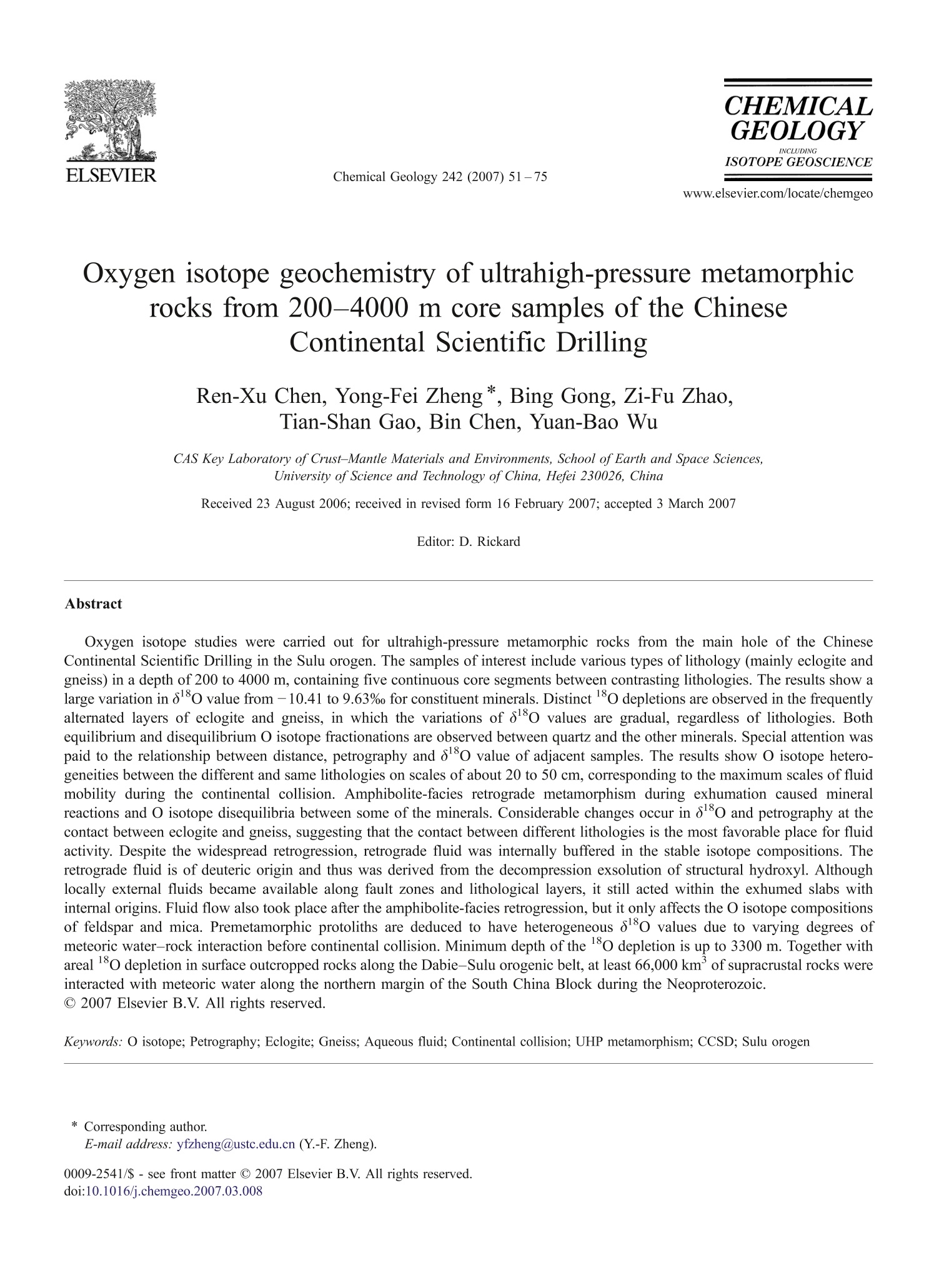
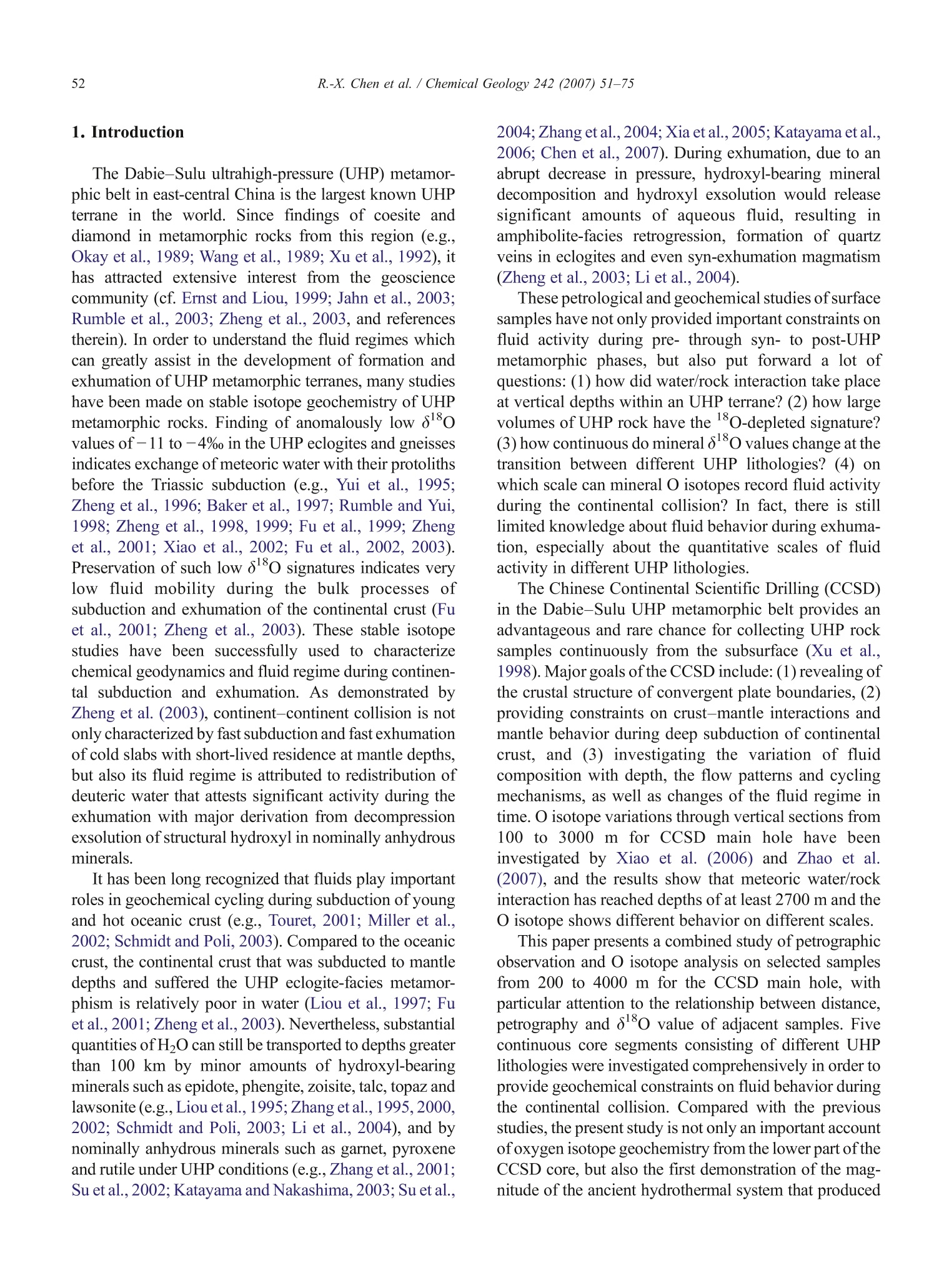
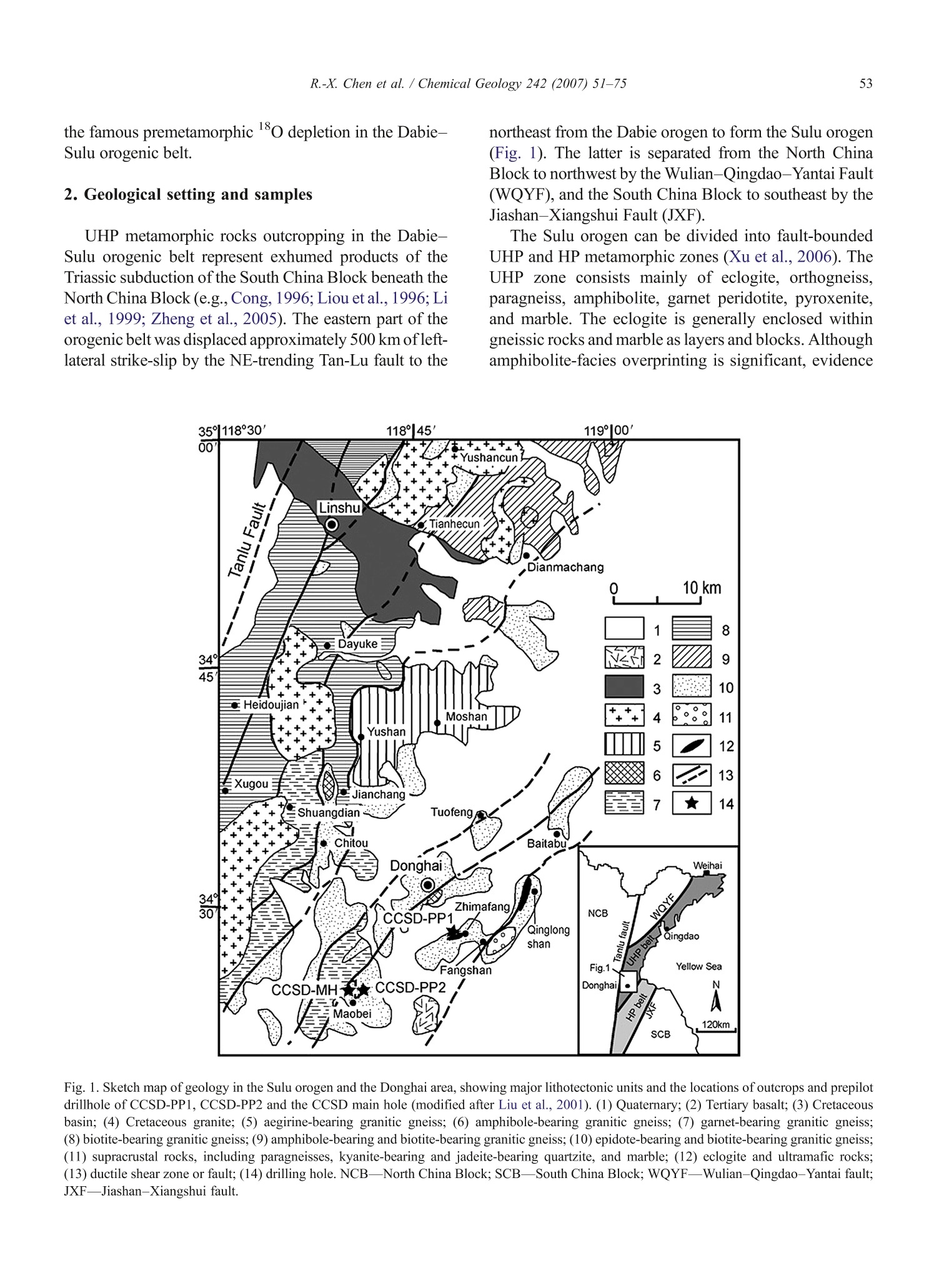

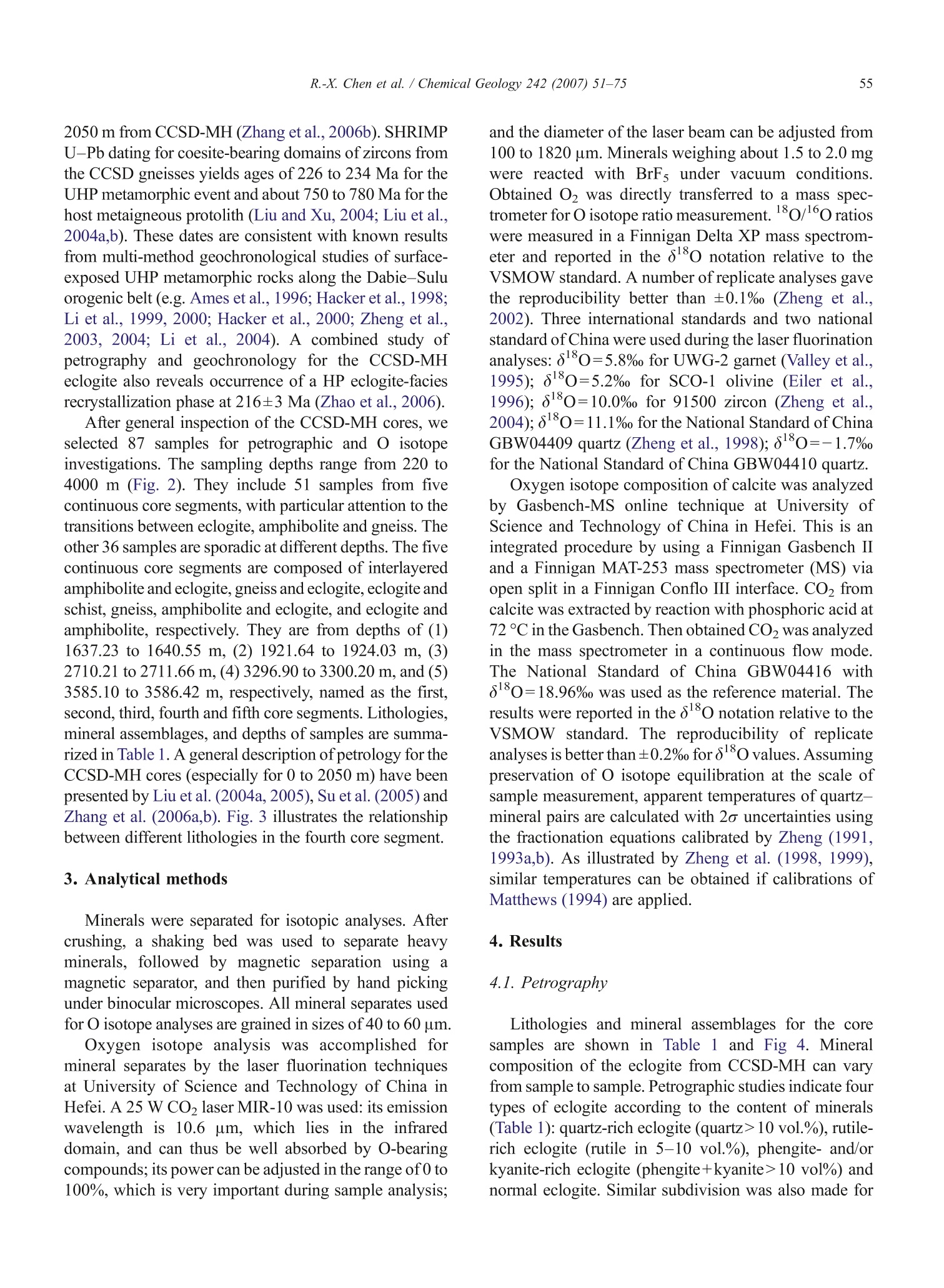
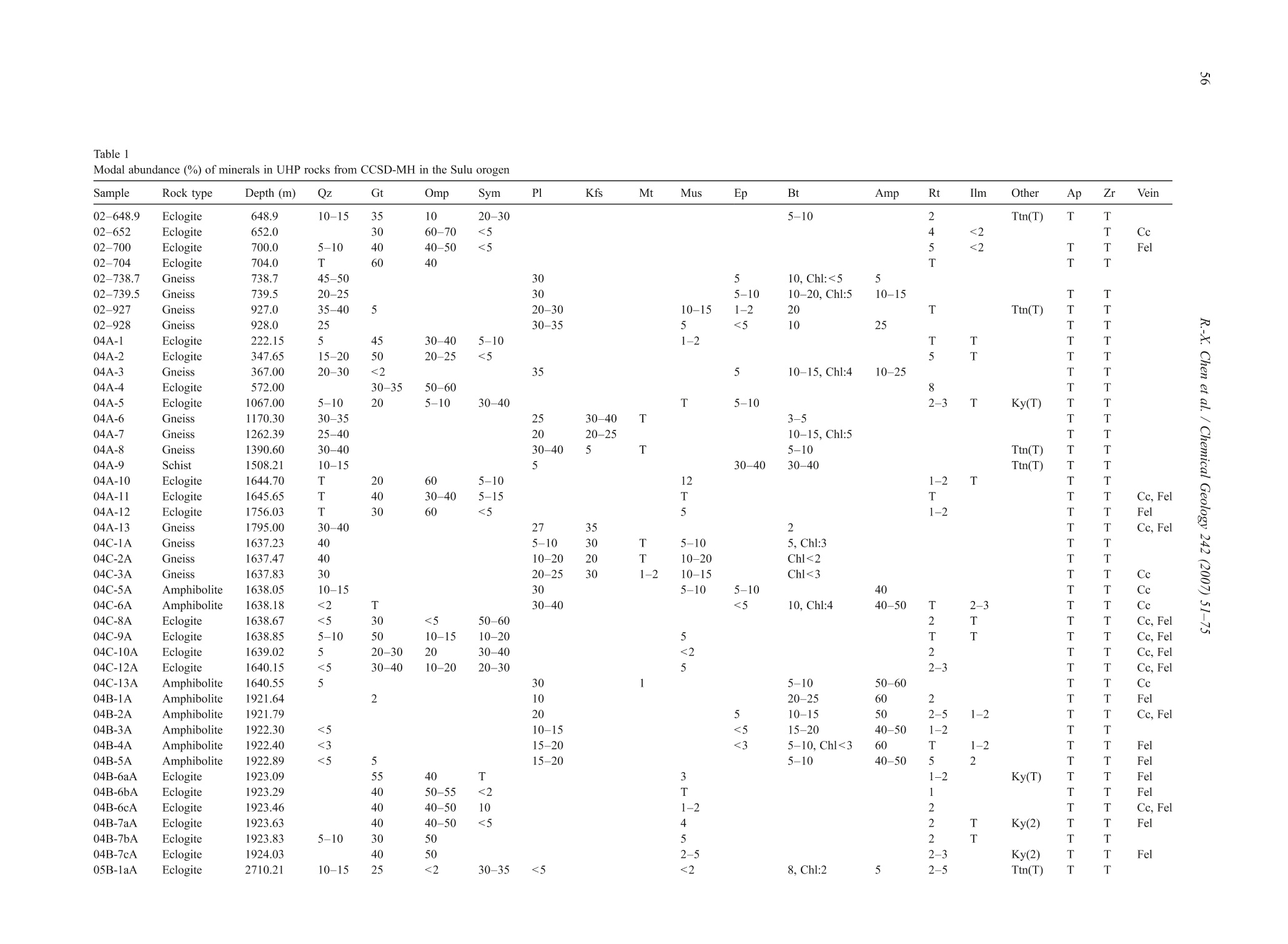
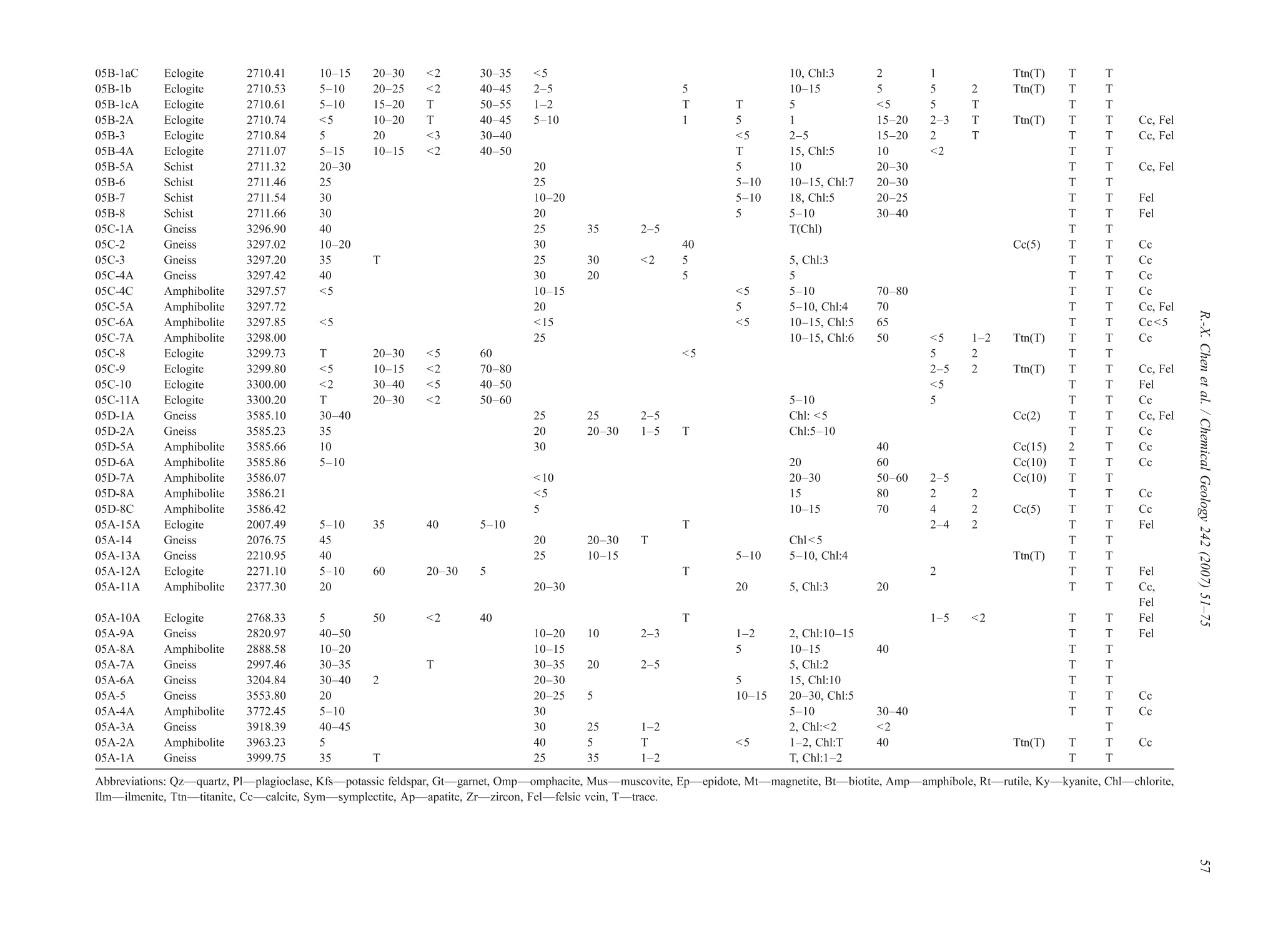
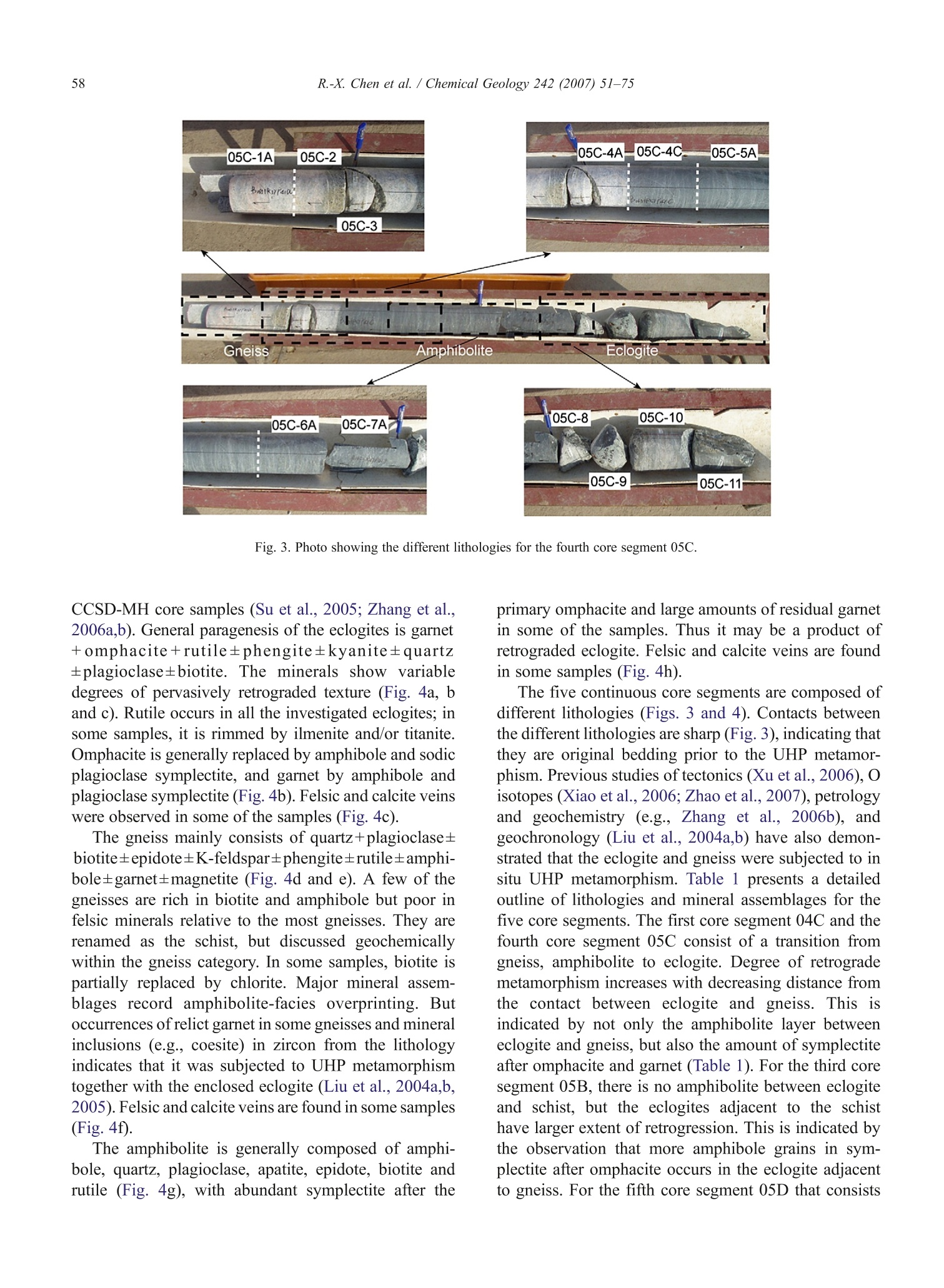
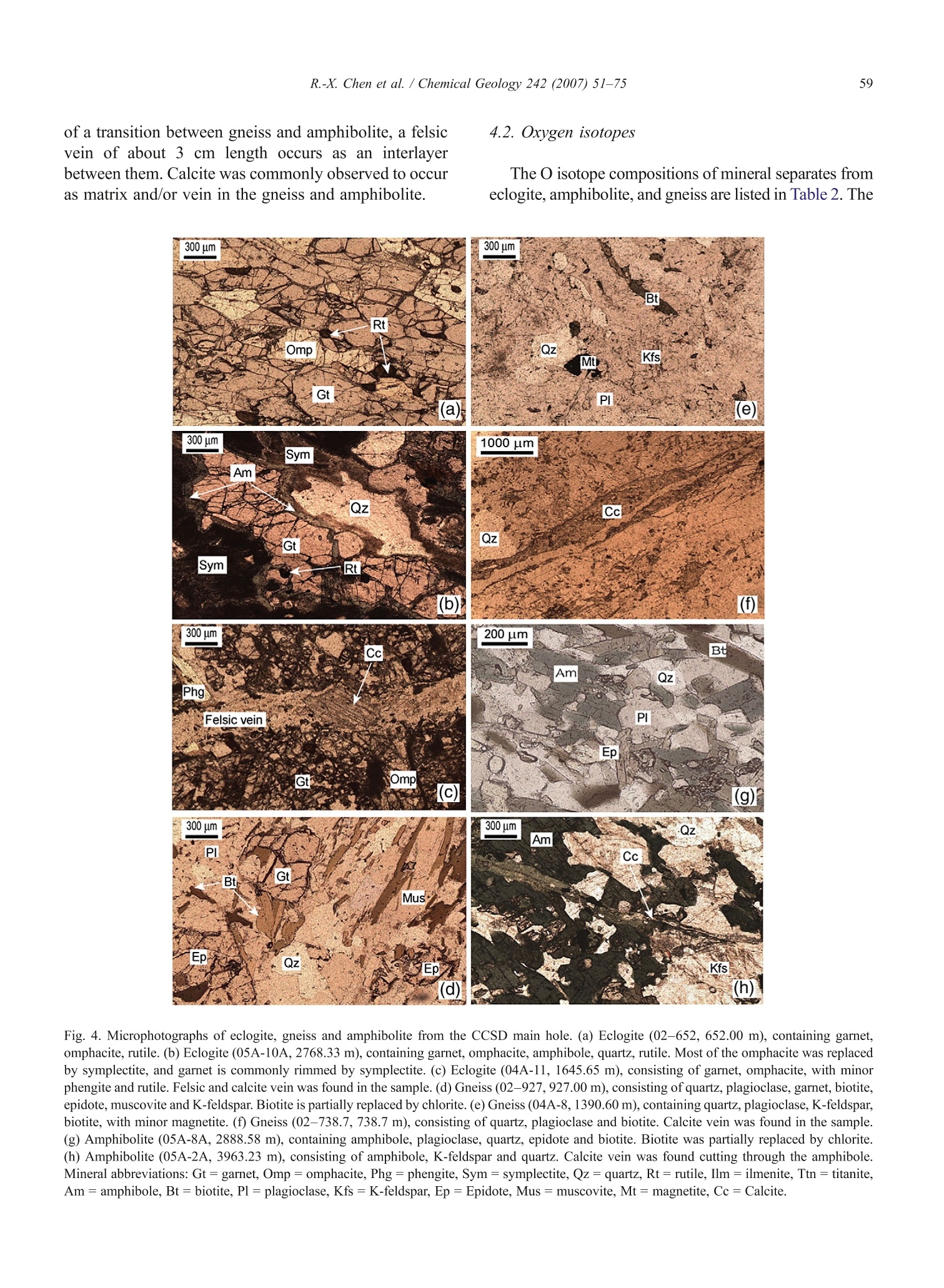
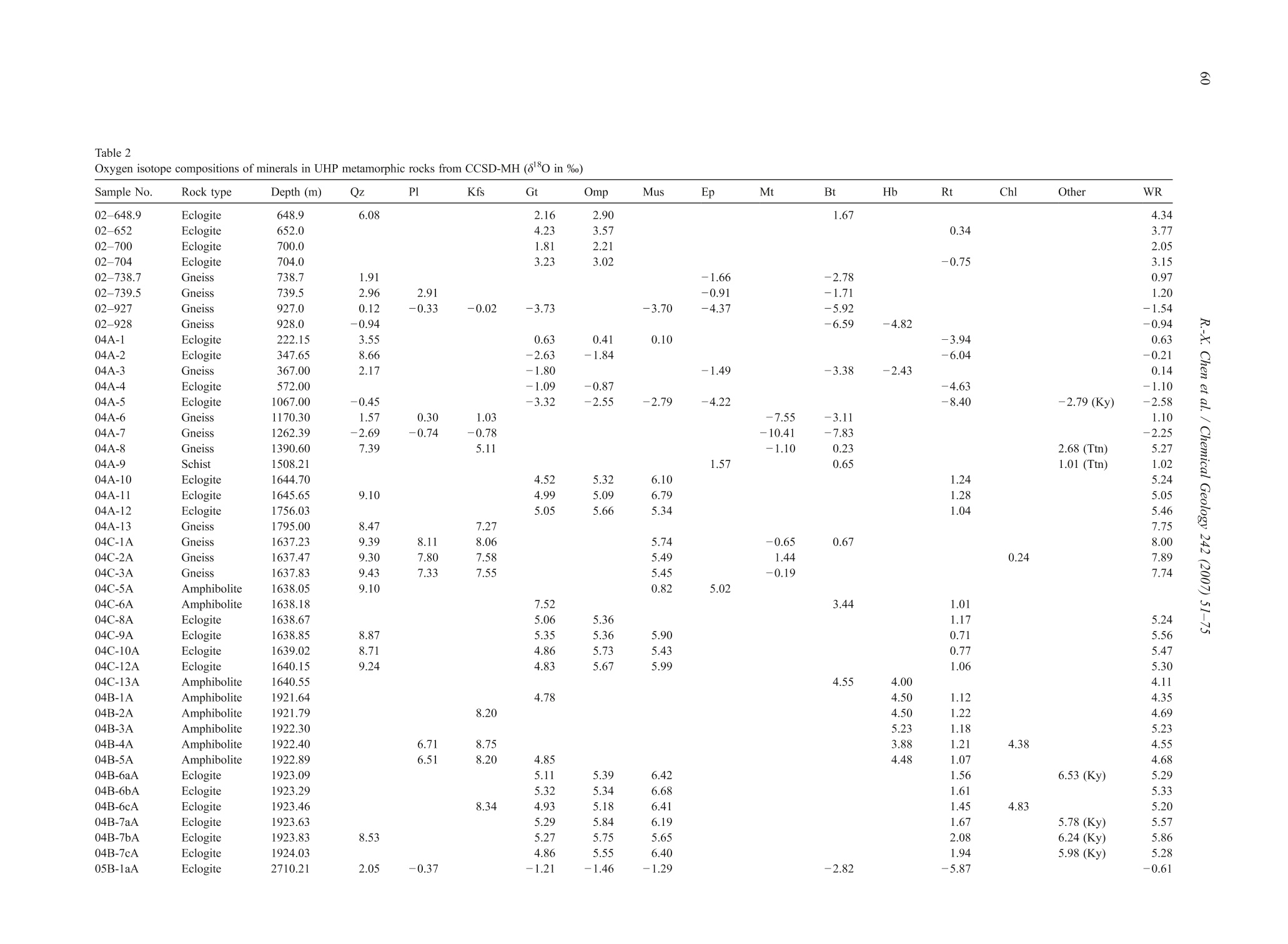
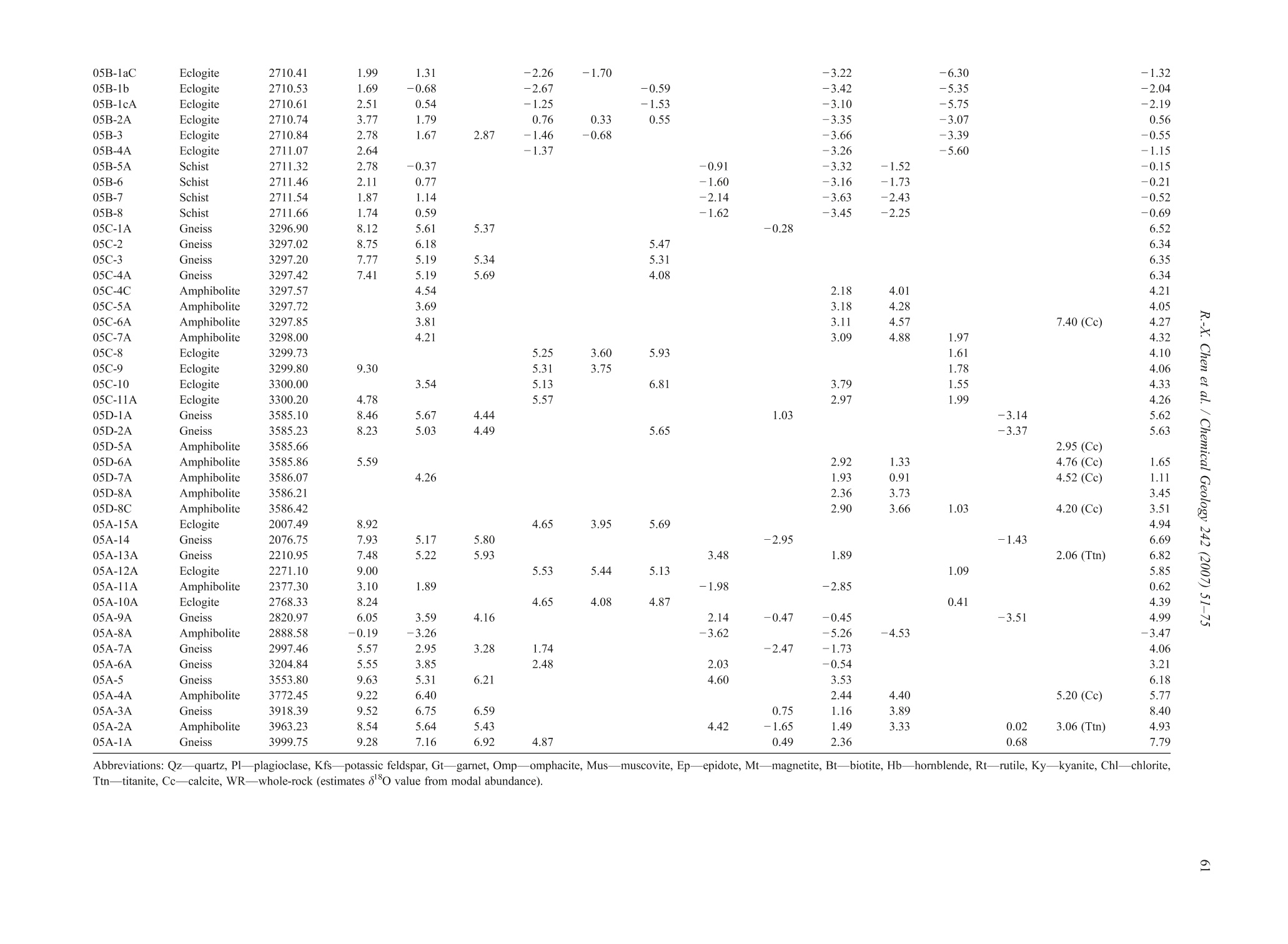
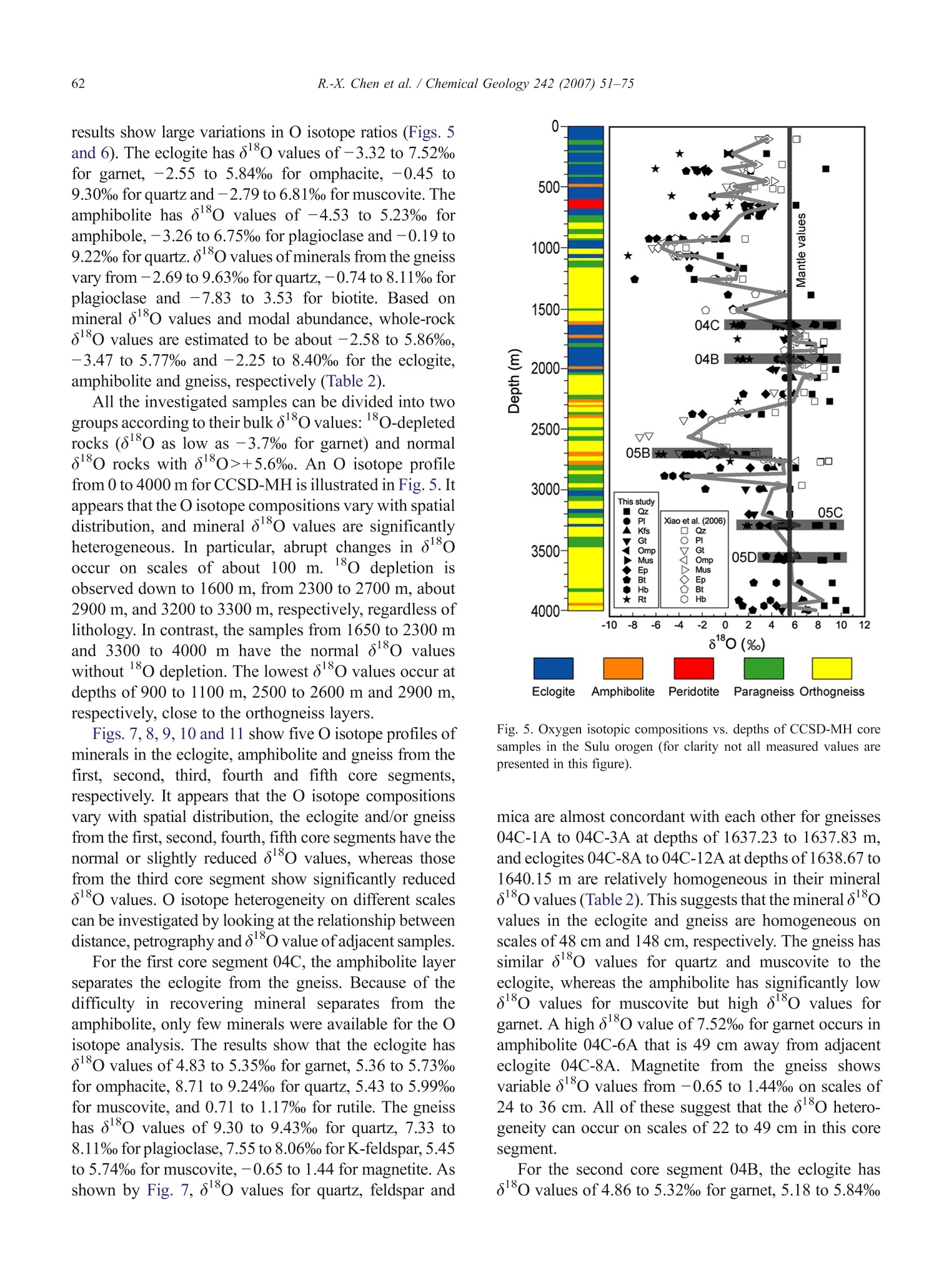
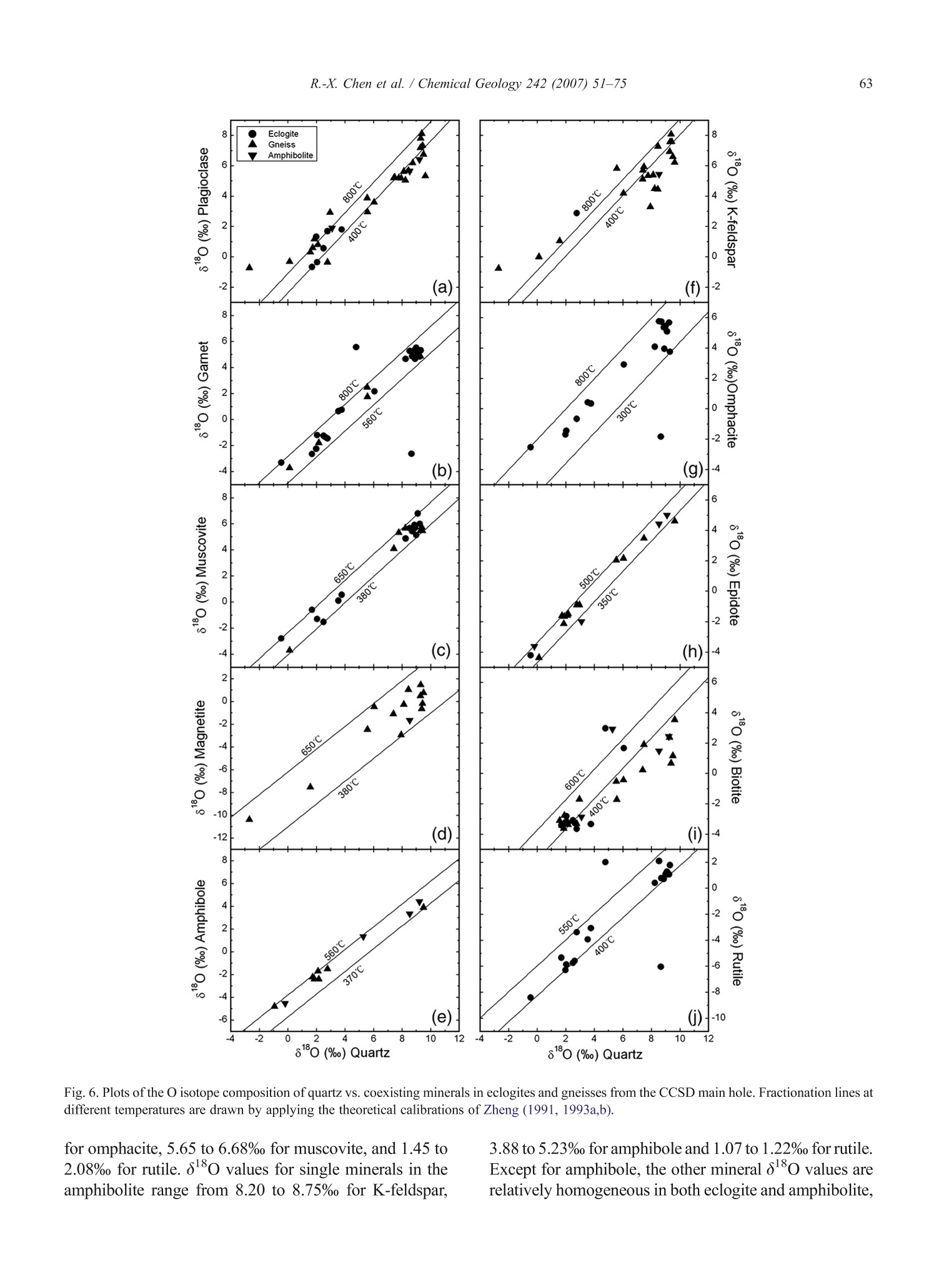
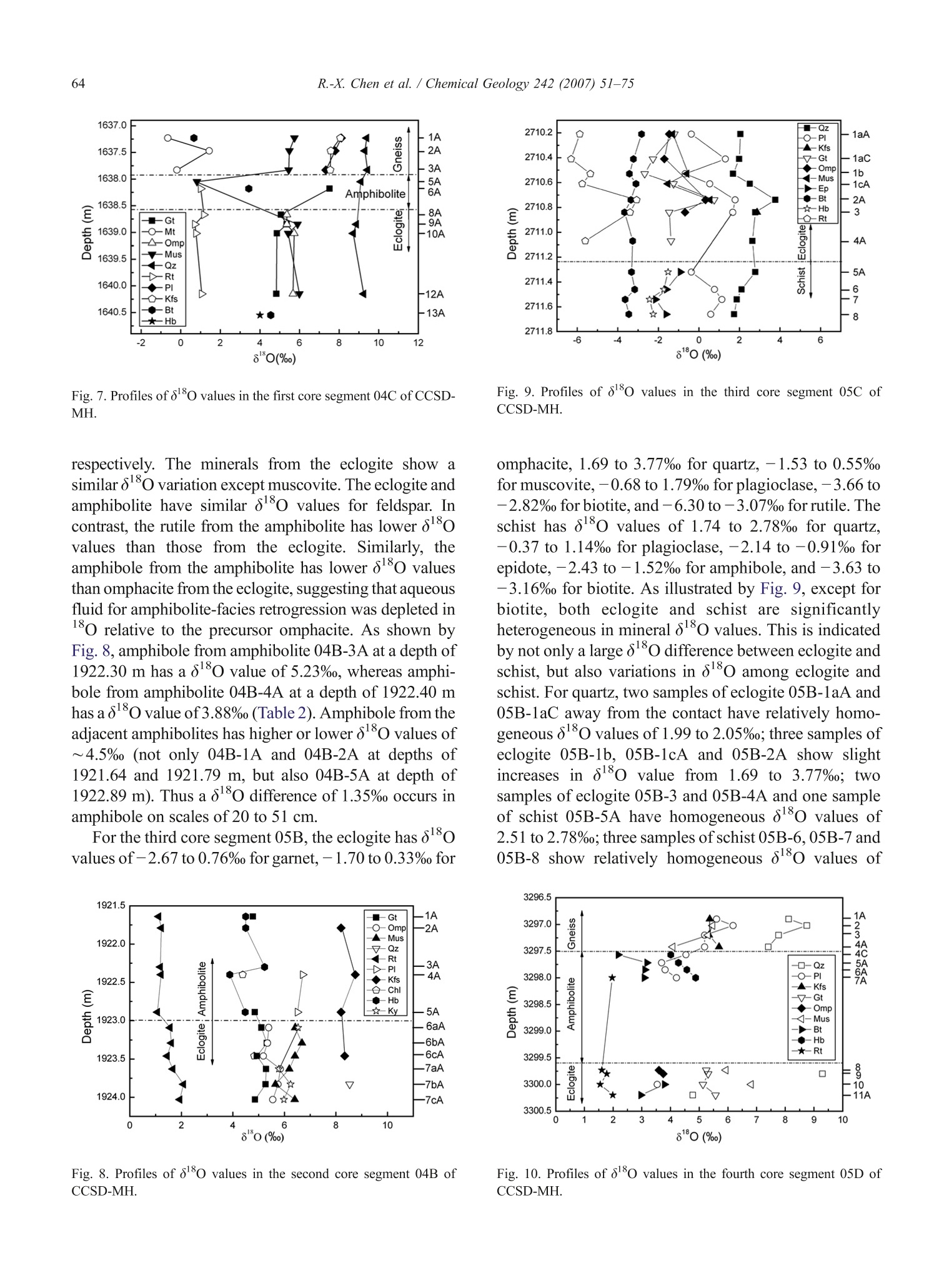
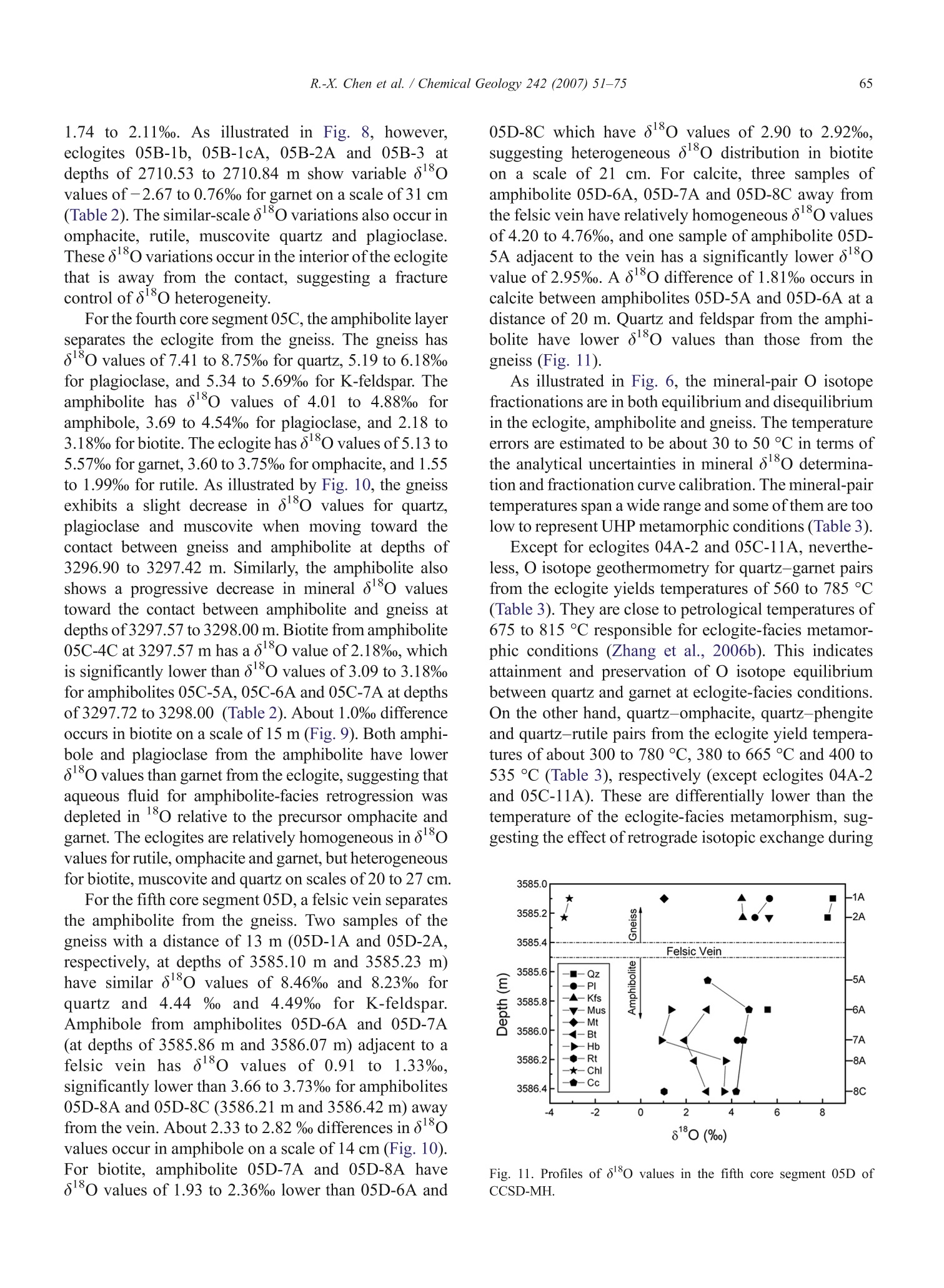
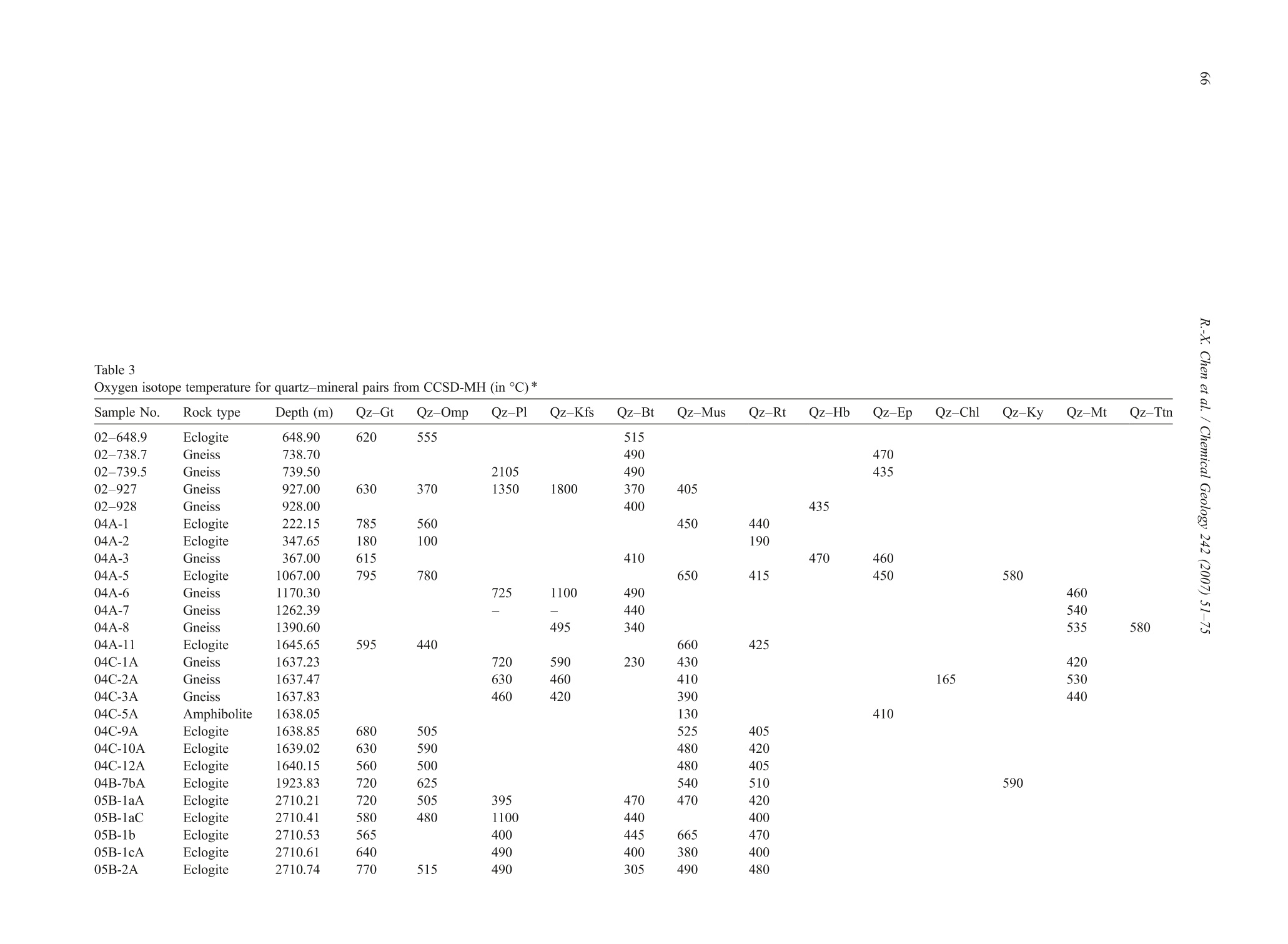
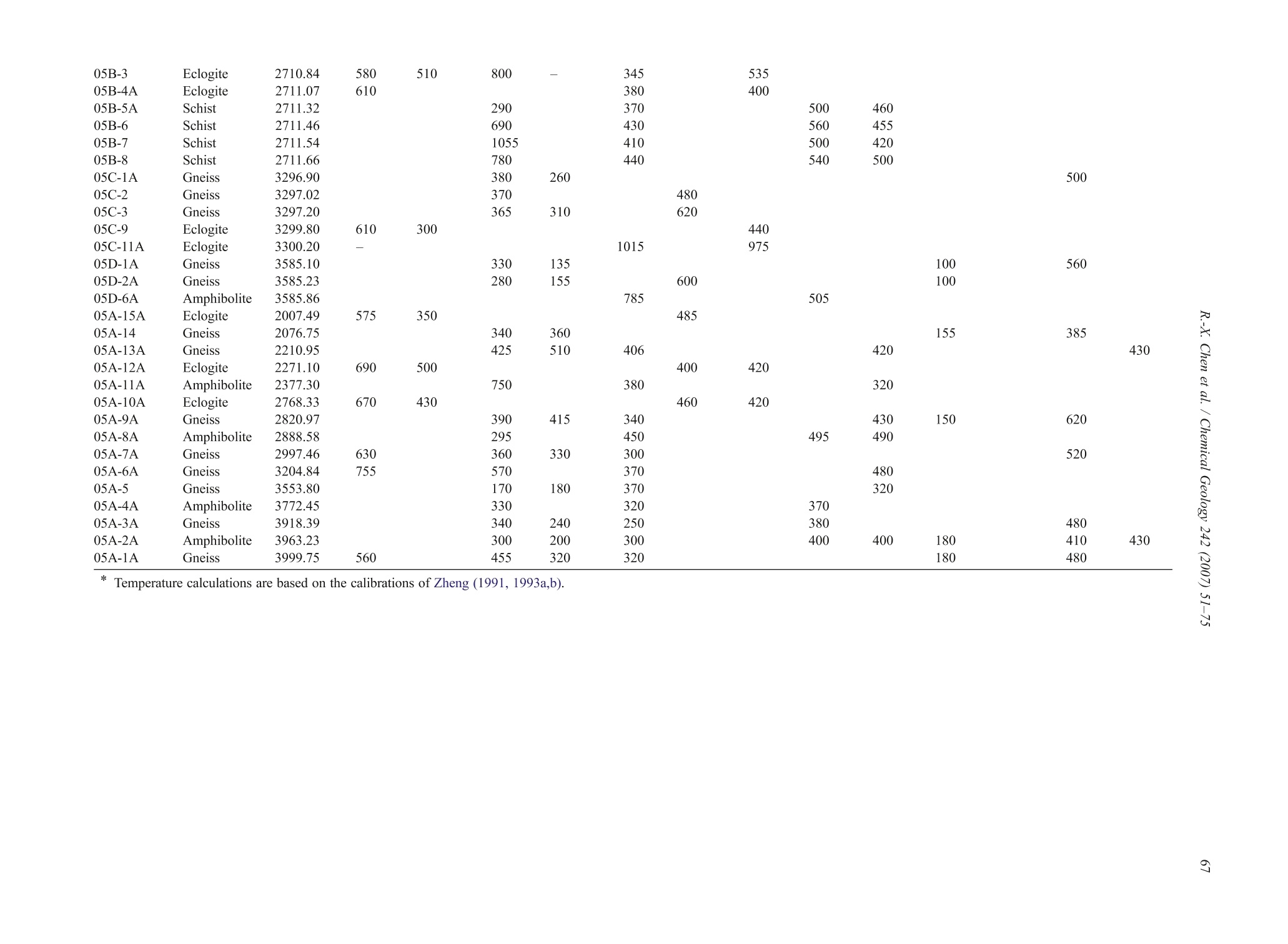
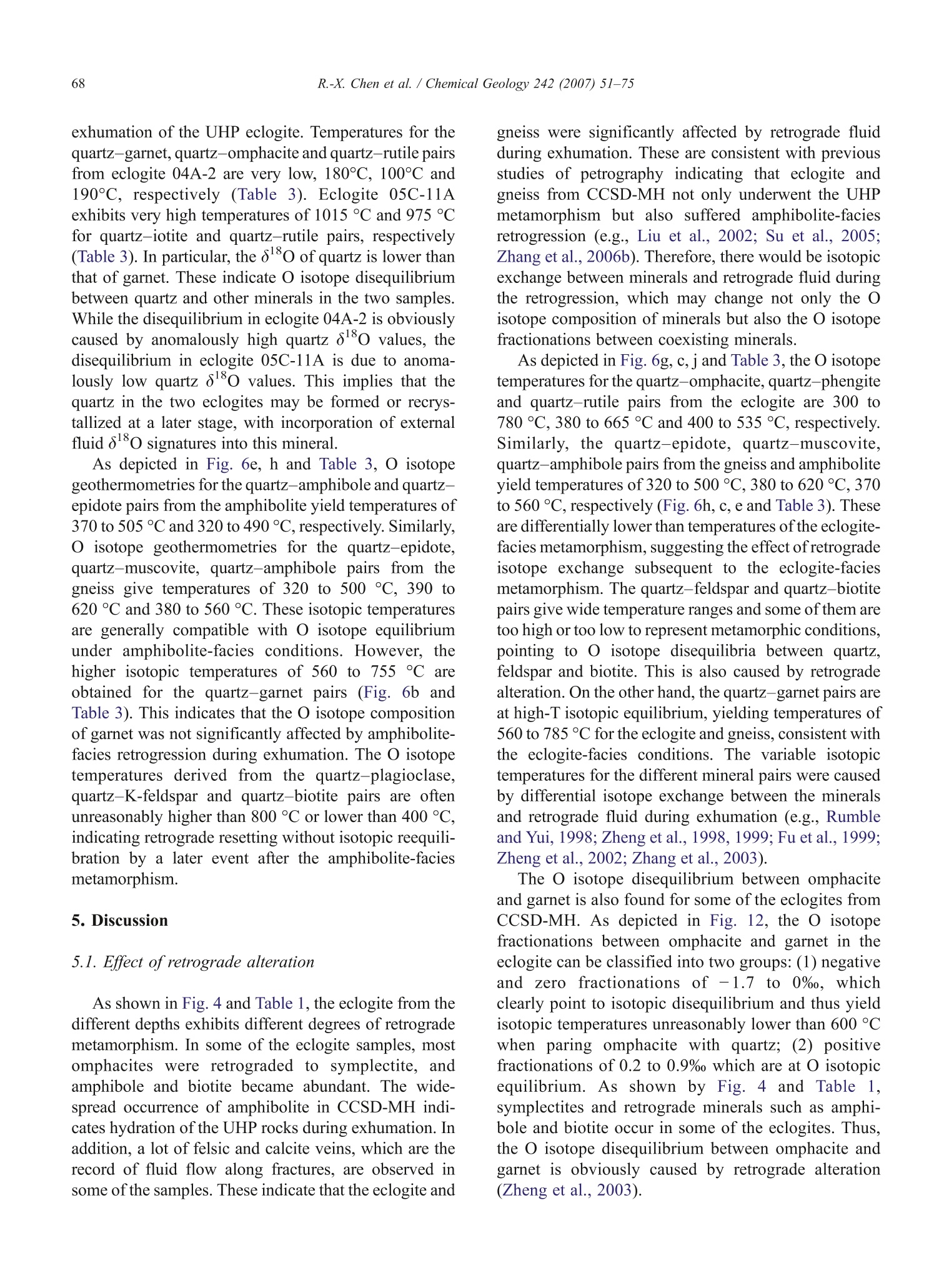

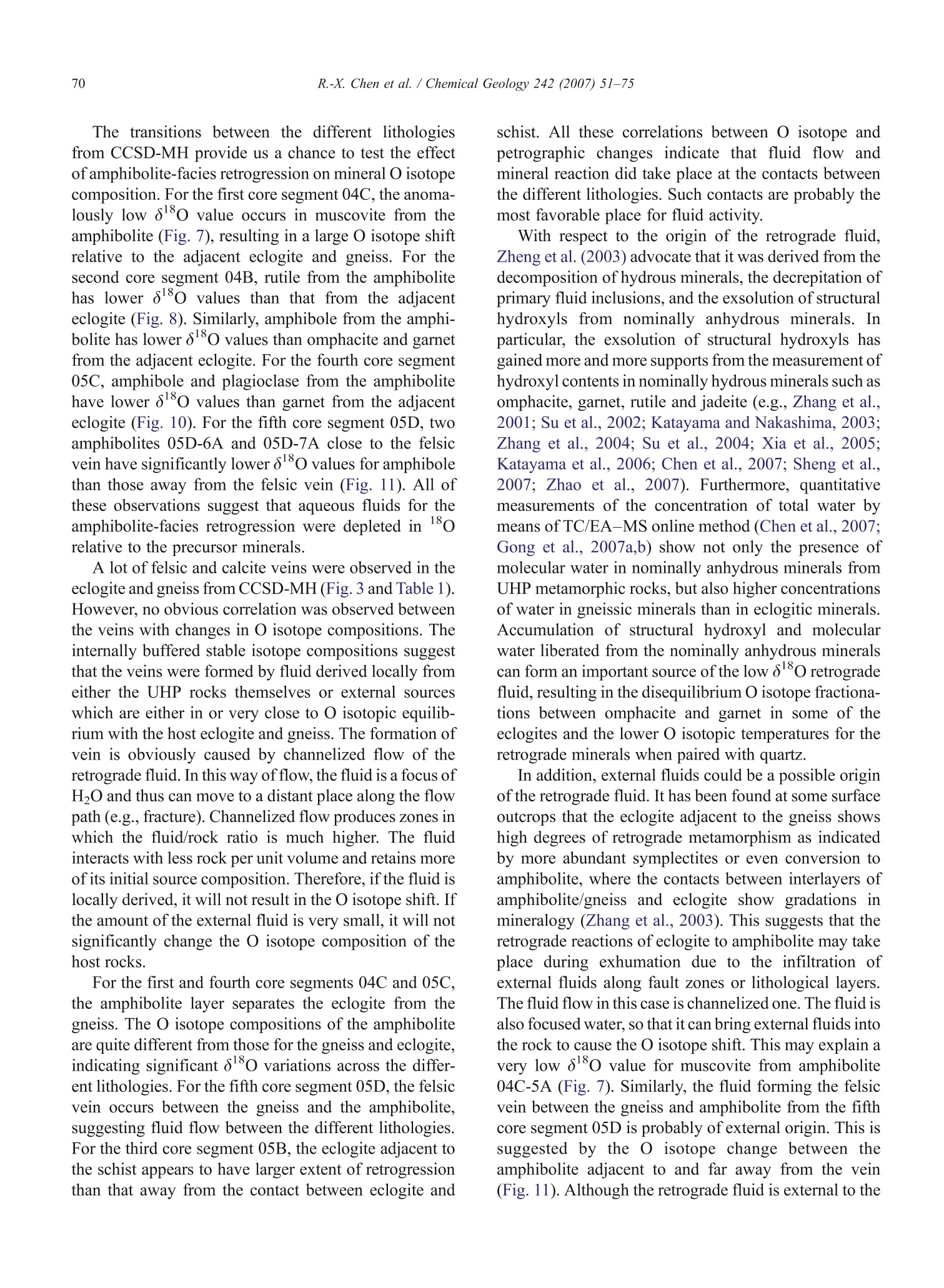
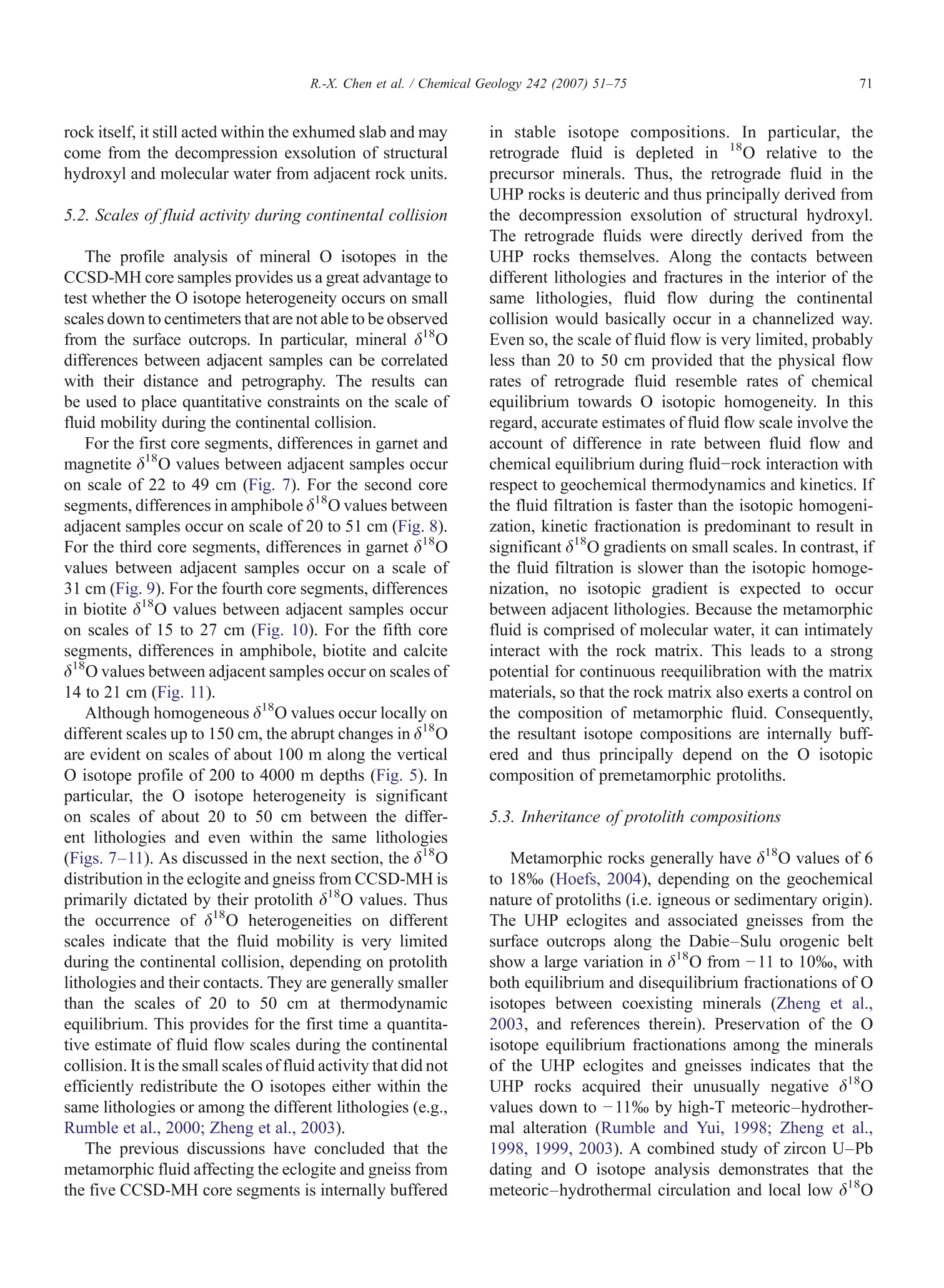
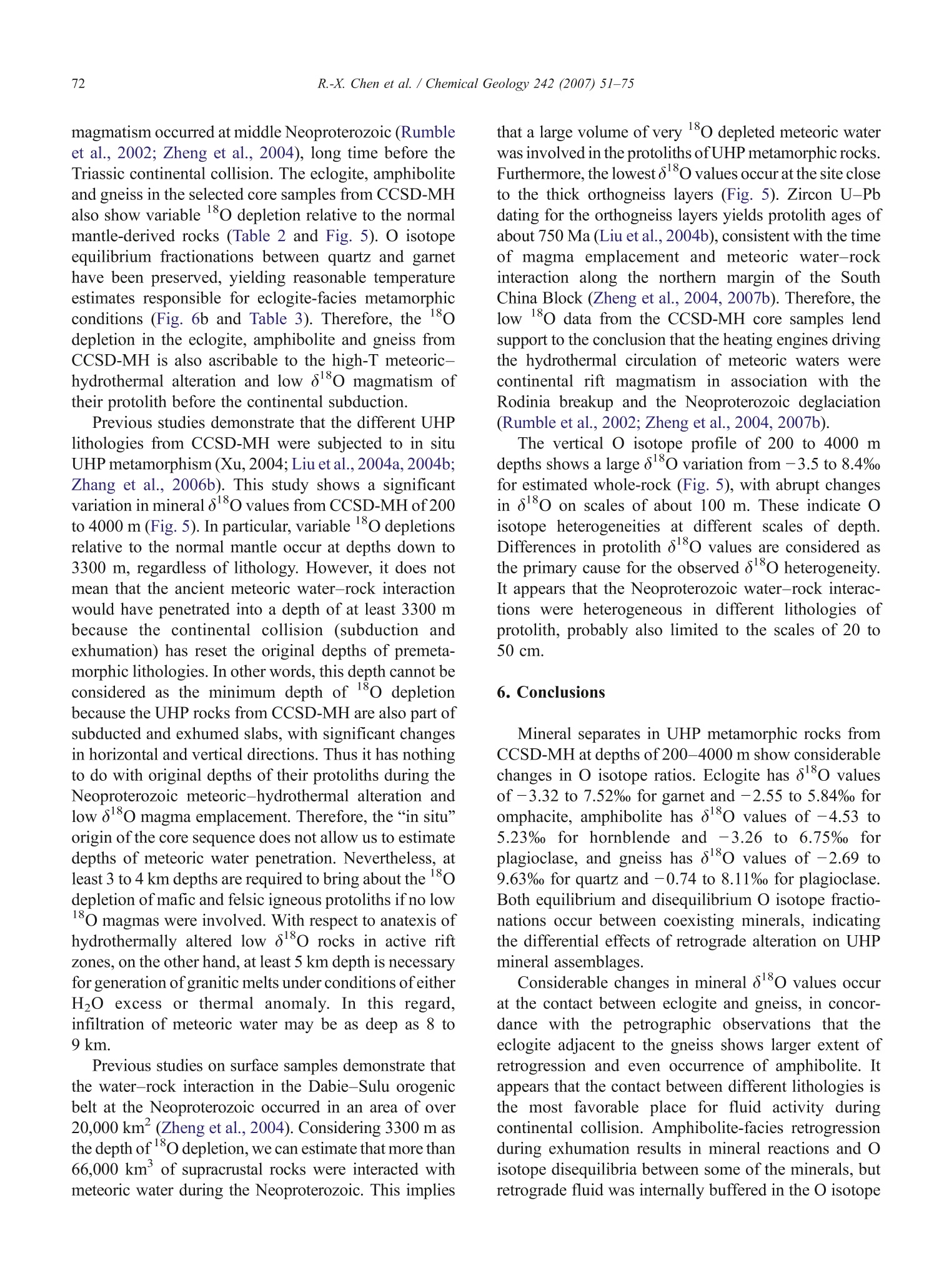

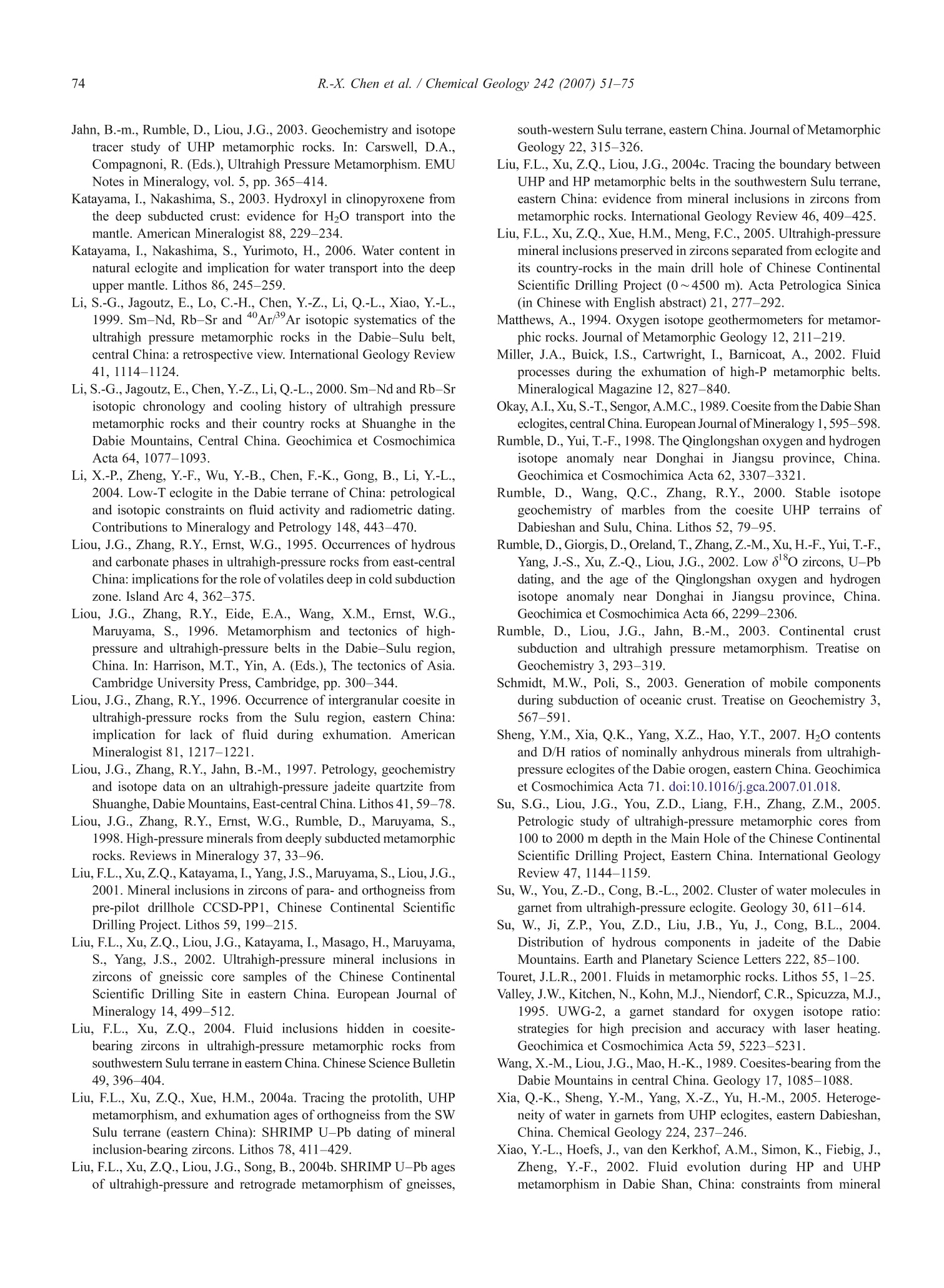

还剩23页未读,是否继续阅读?
上海凯来仪器有限公司为您提供《超高压变质岩中氧同位素检测方案(激光剥蚀进样)》,该方案主要用于其他中氧同位素检测,参考标准--,《超高压变质岩中氧同位素检测方案(激光剥蚀进样)》用到的仪器有MIR 102 激光熔融加热系统
推荐专场
相关方案
更多
该厂商其他方案
更多










